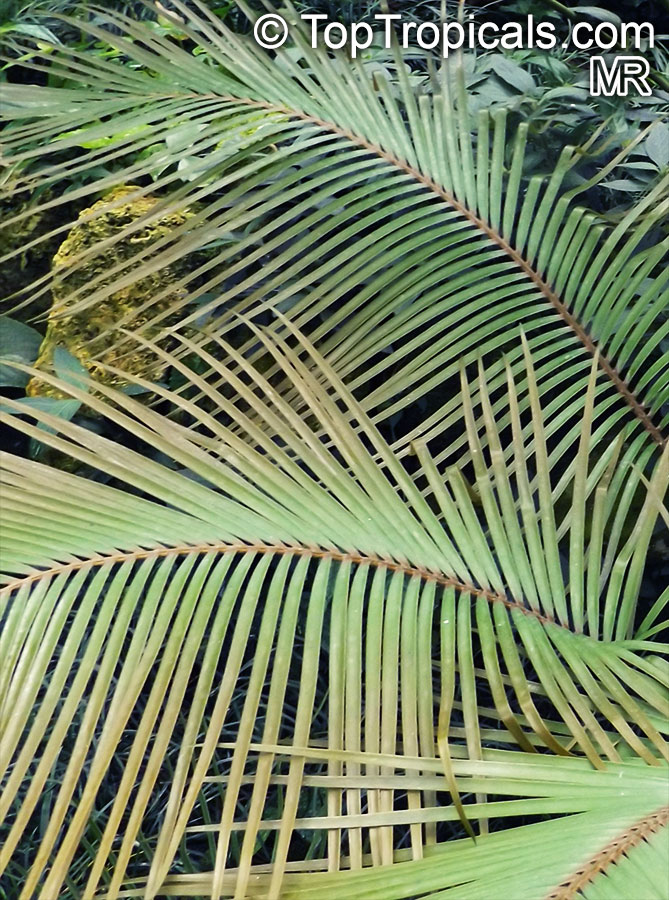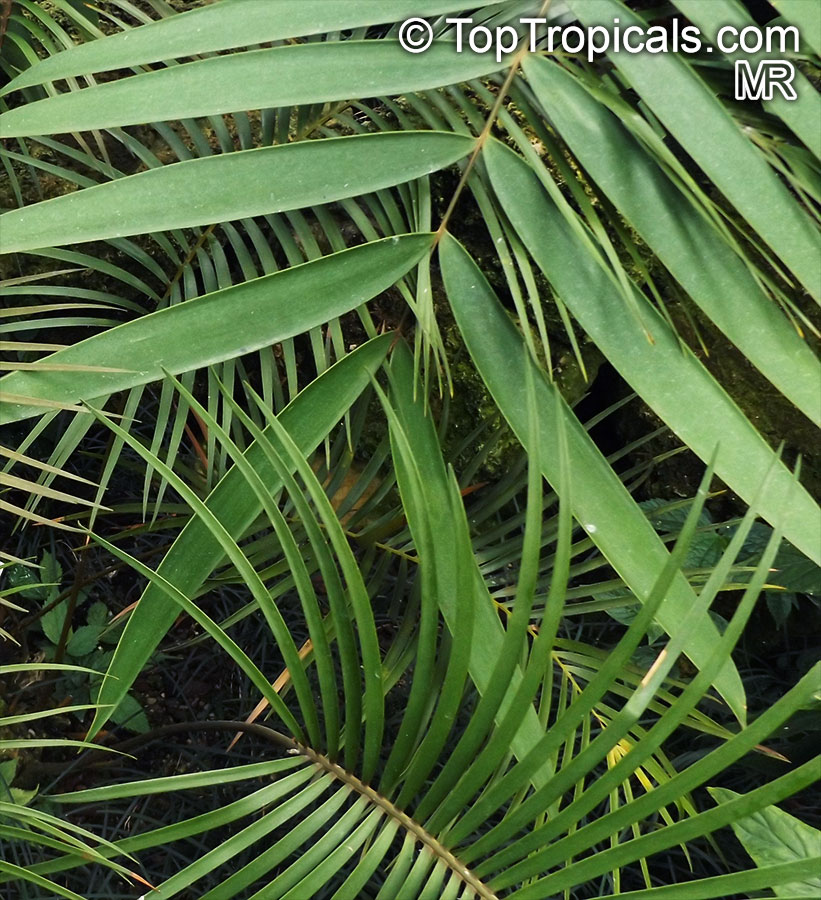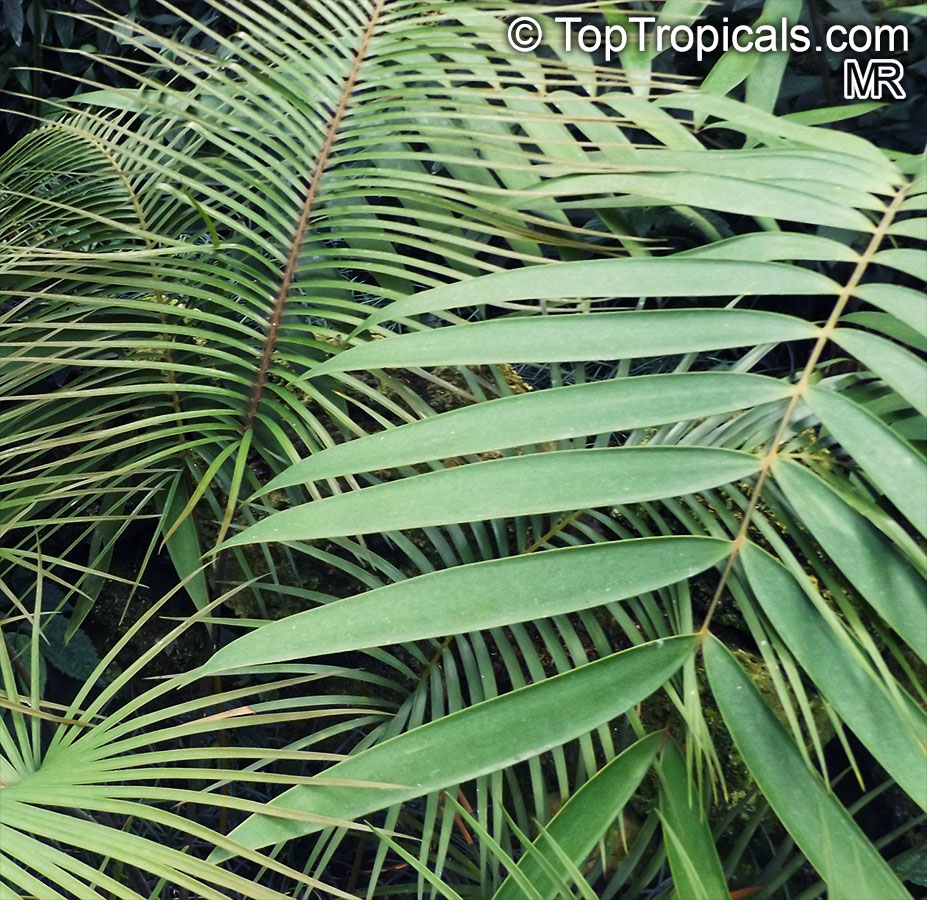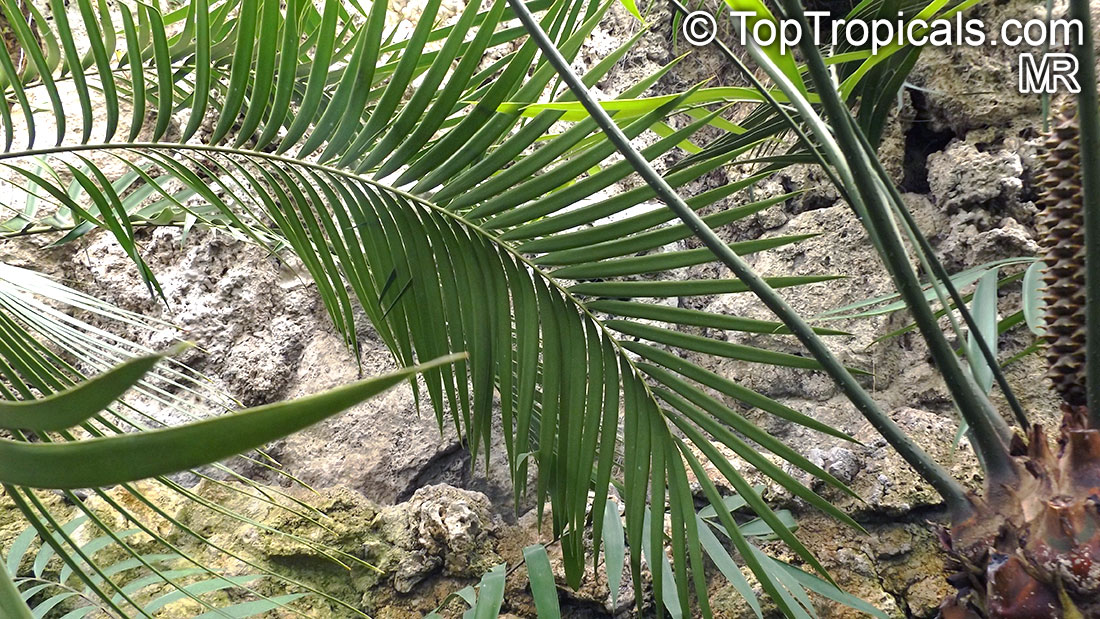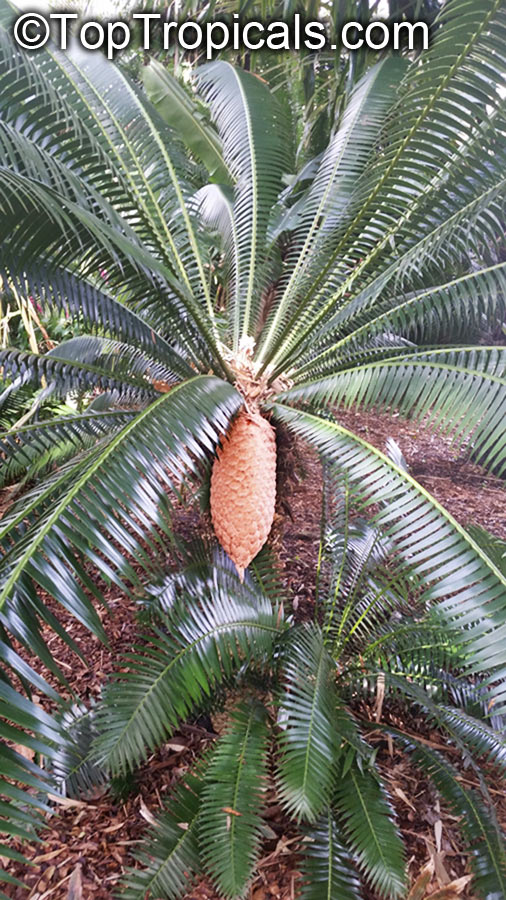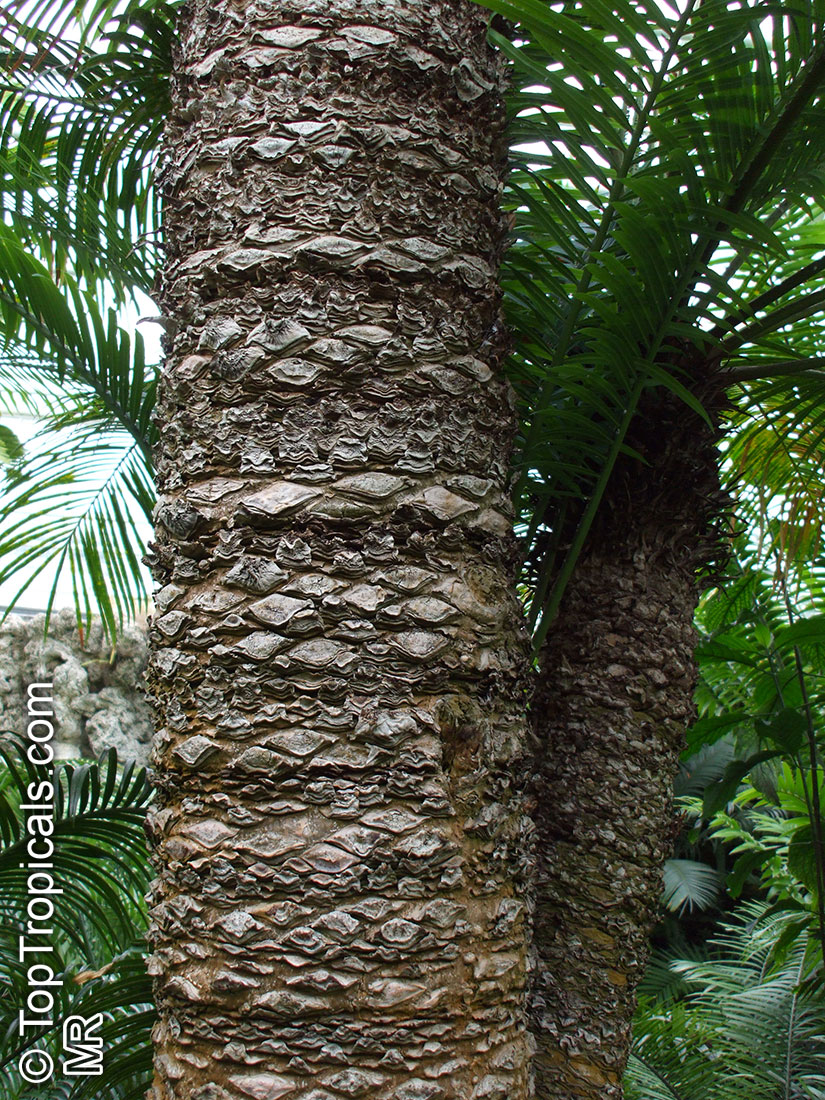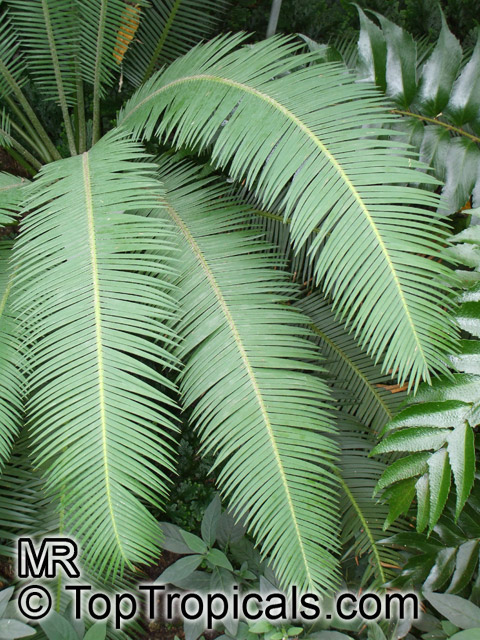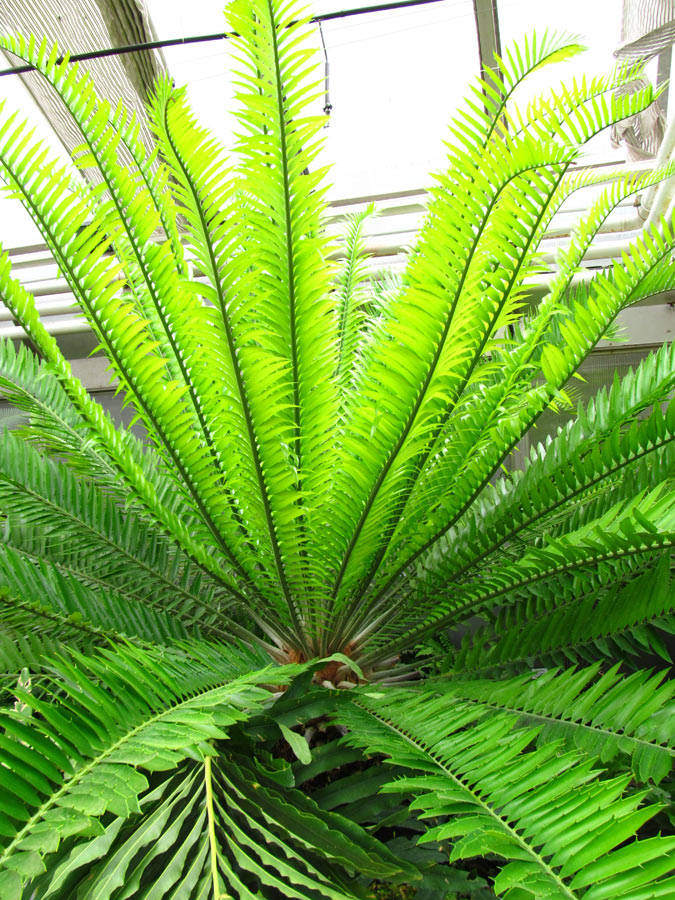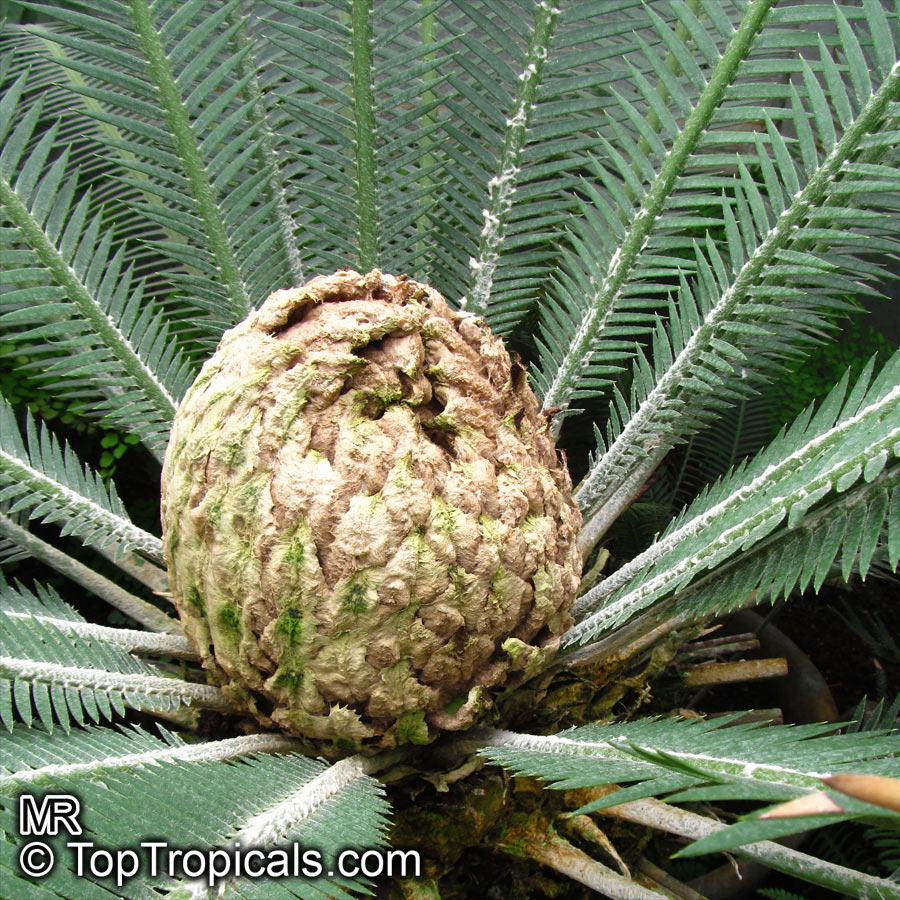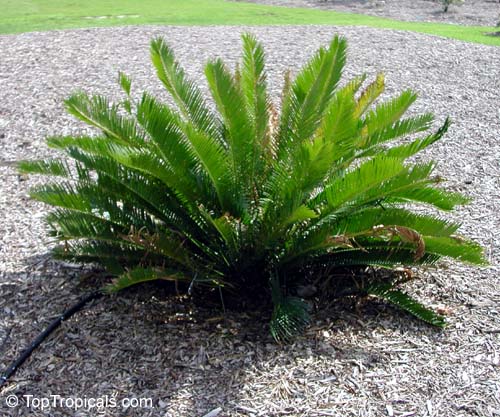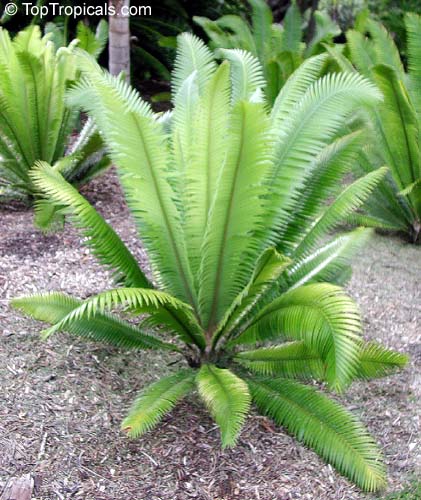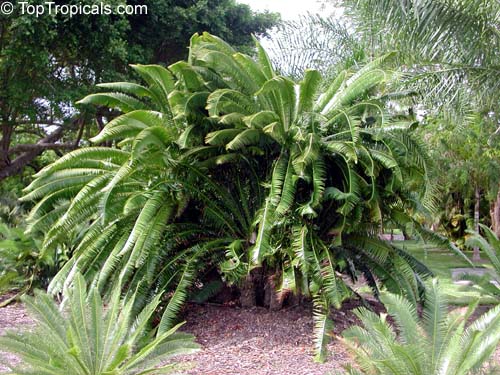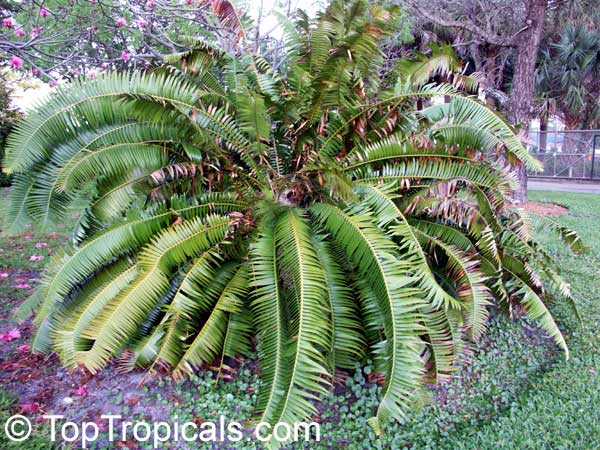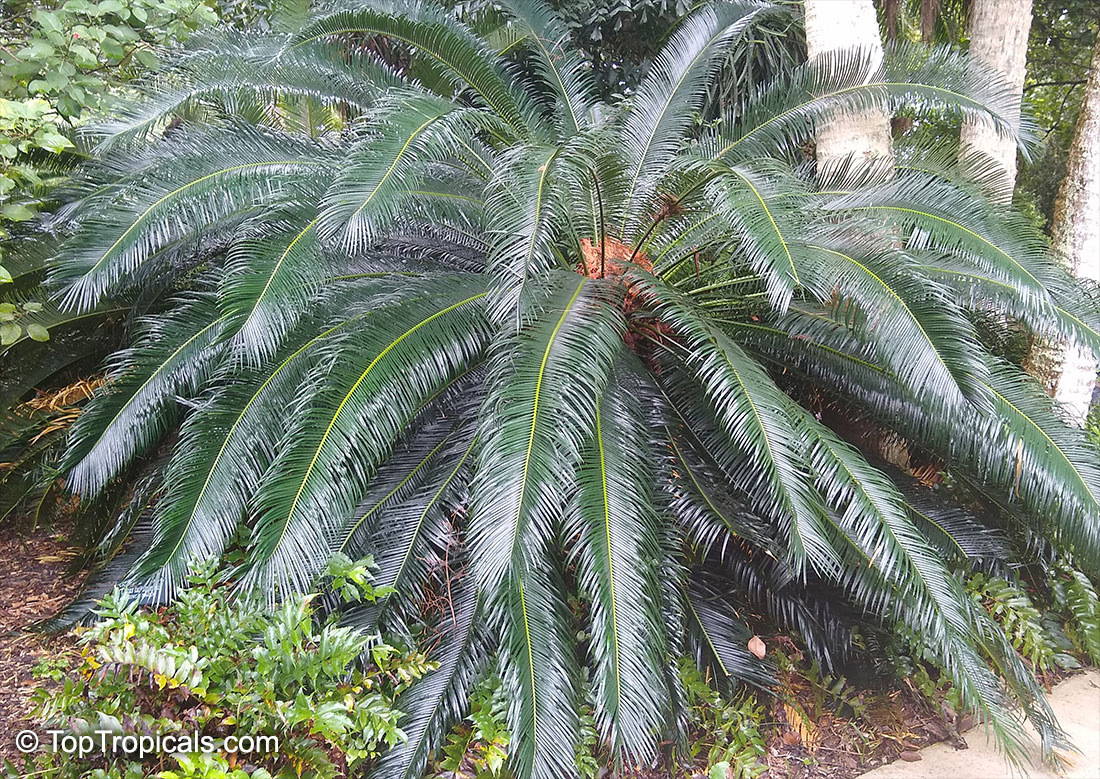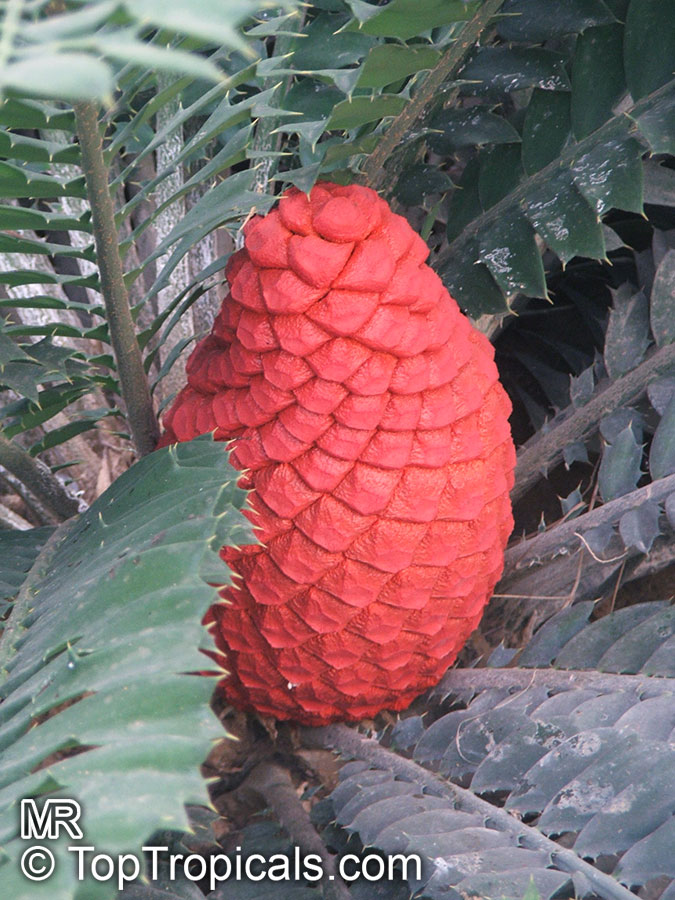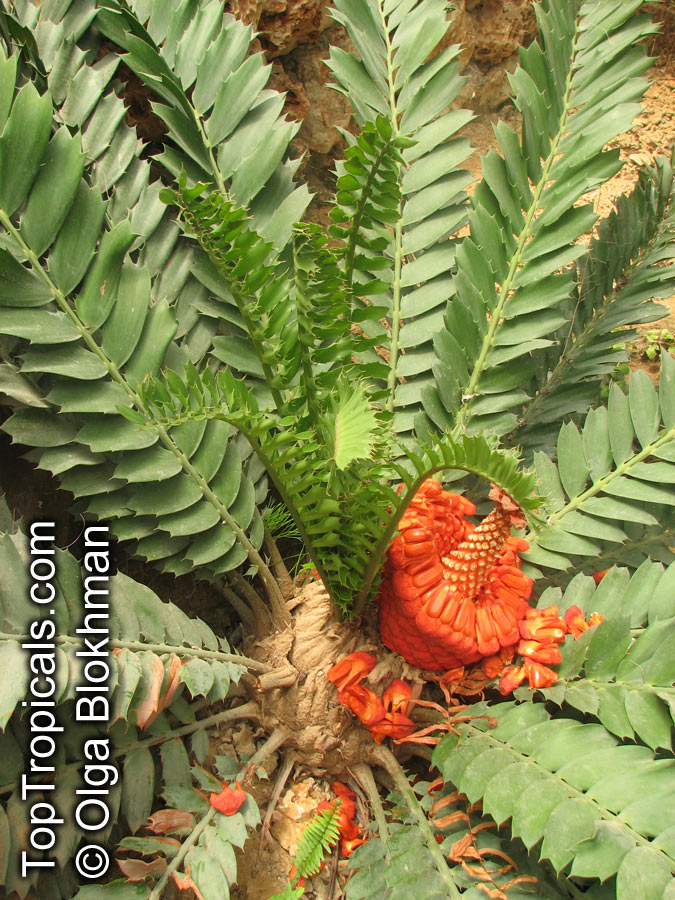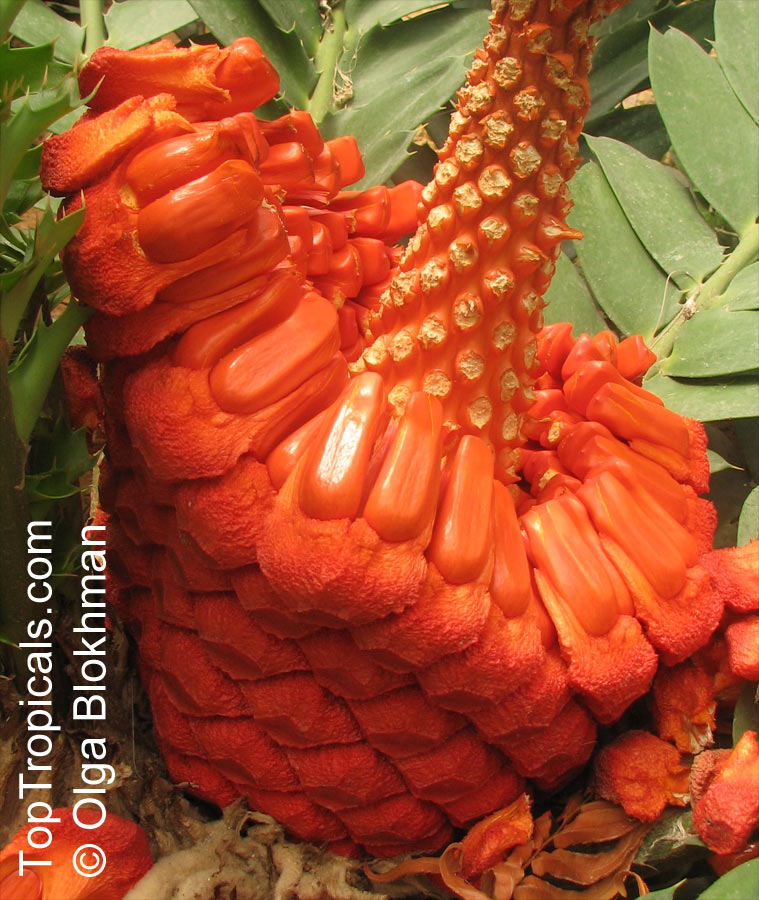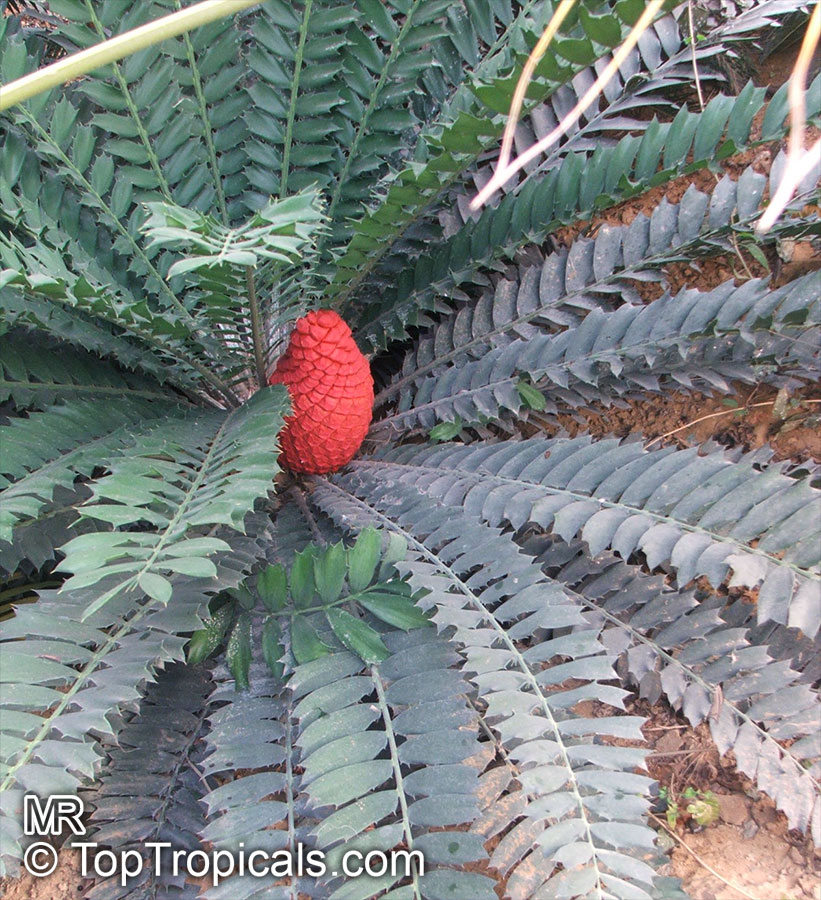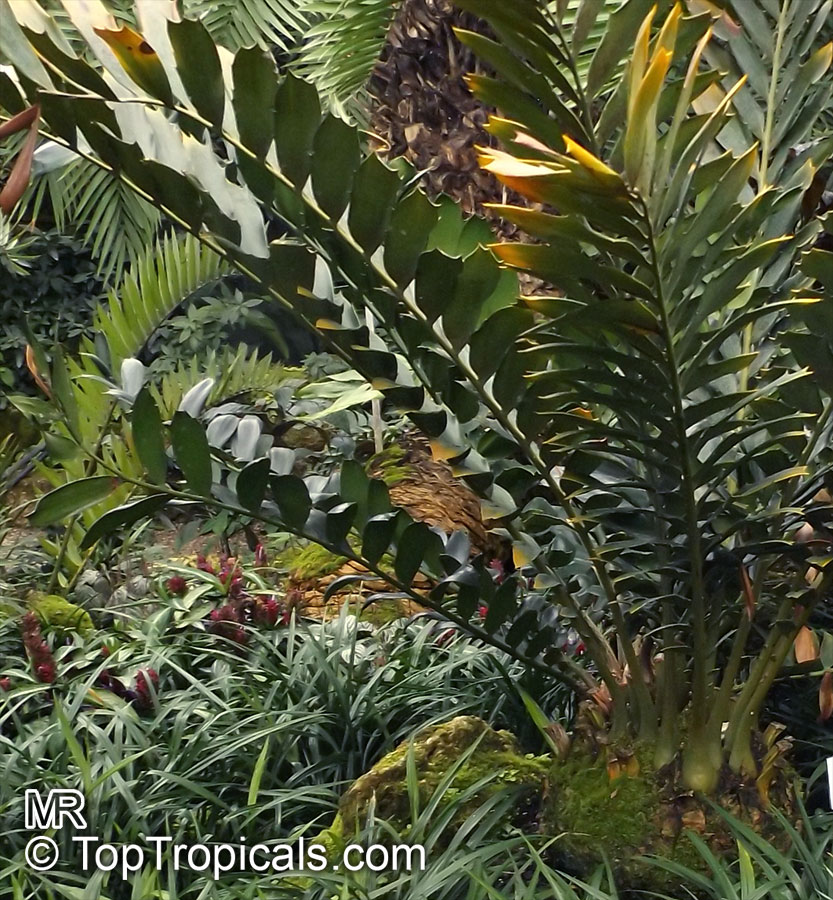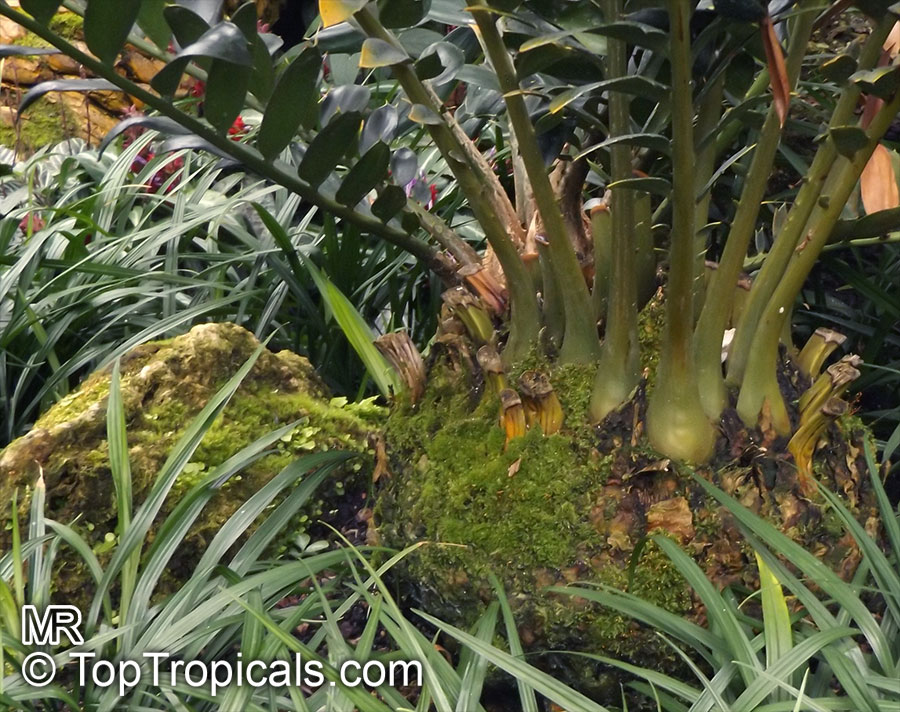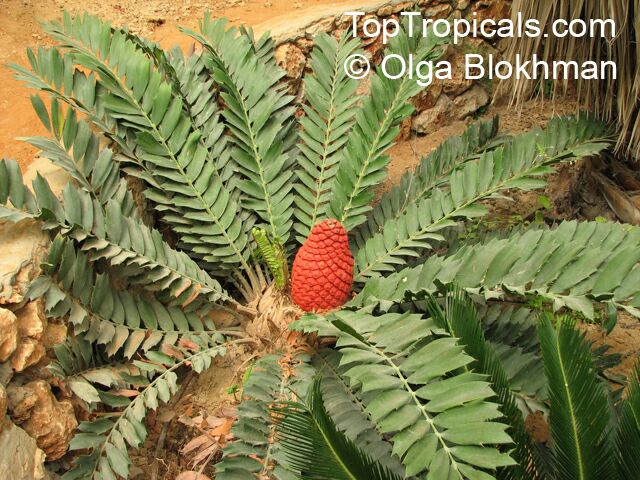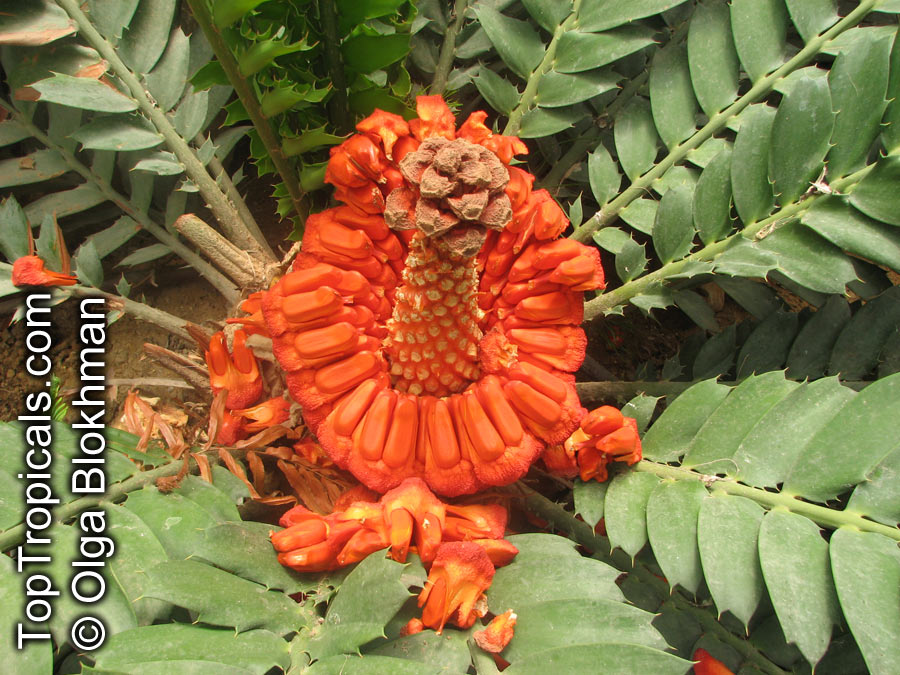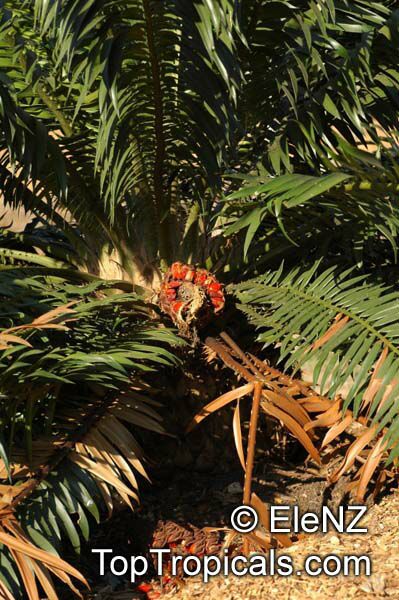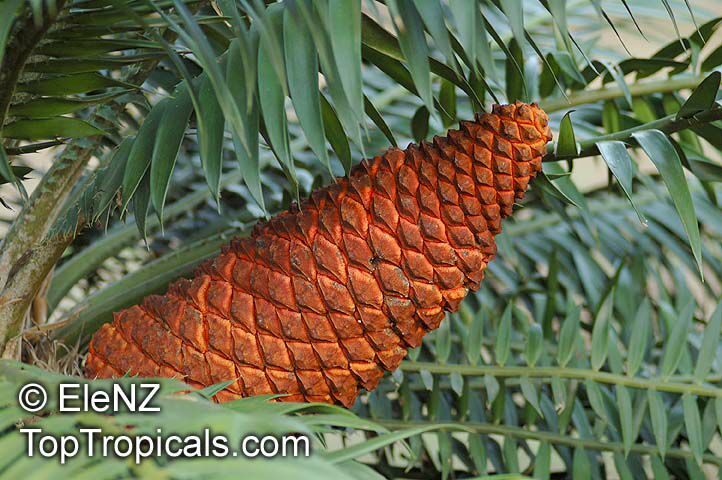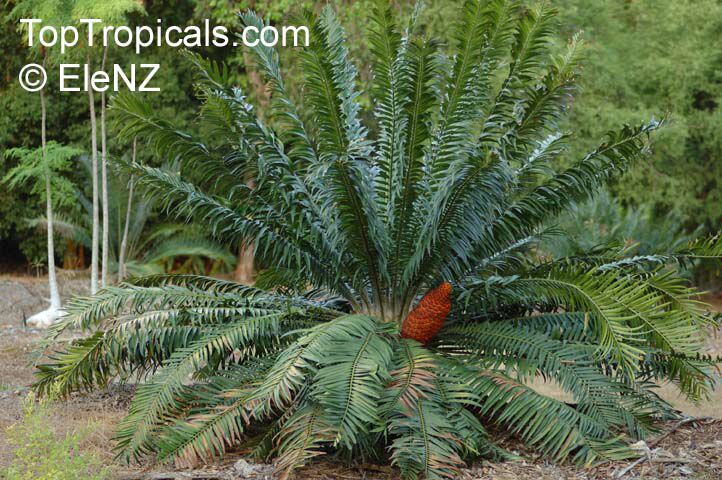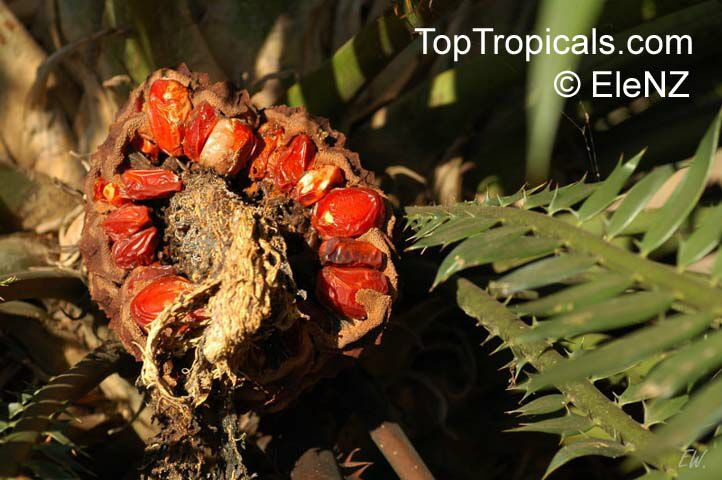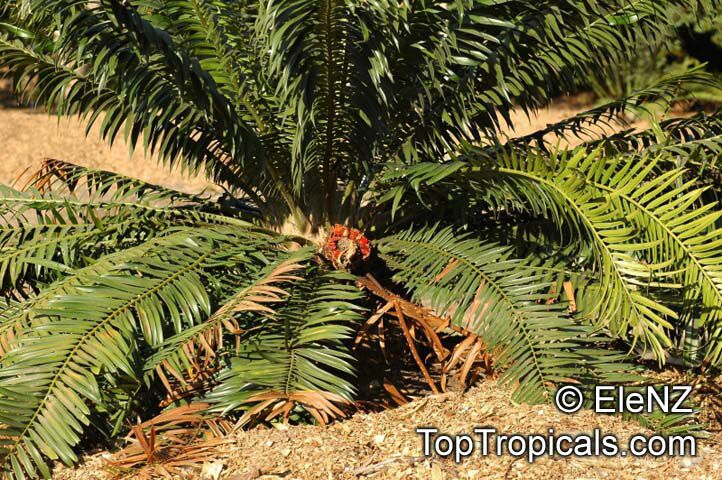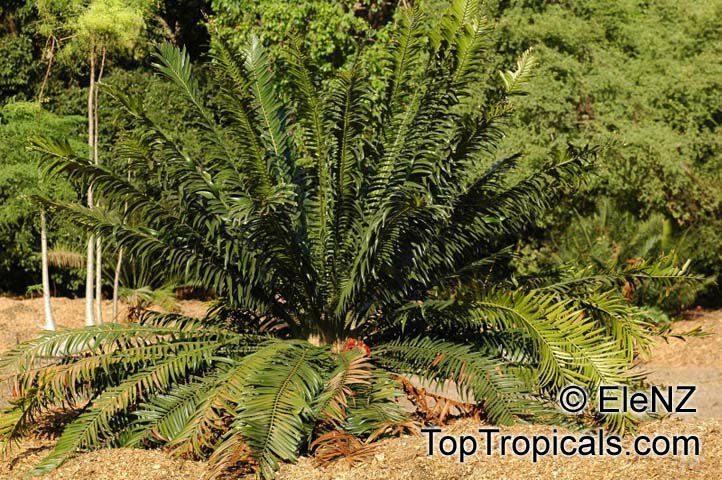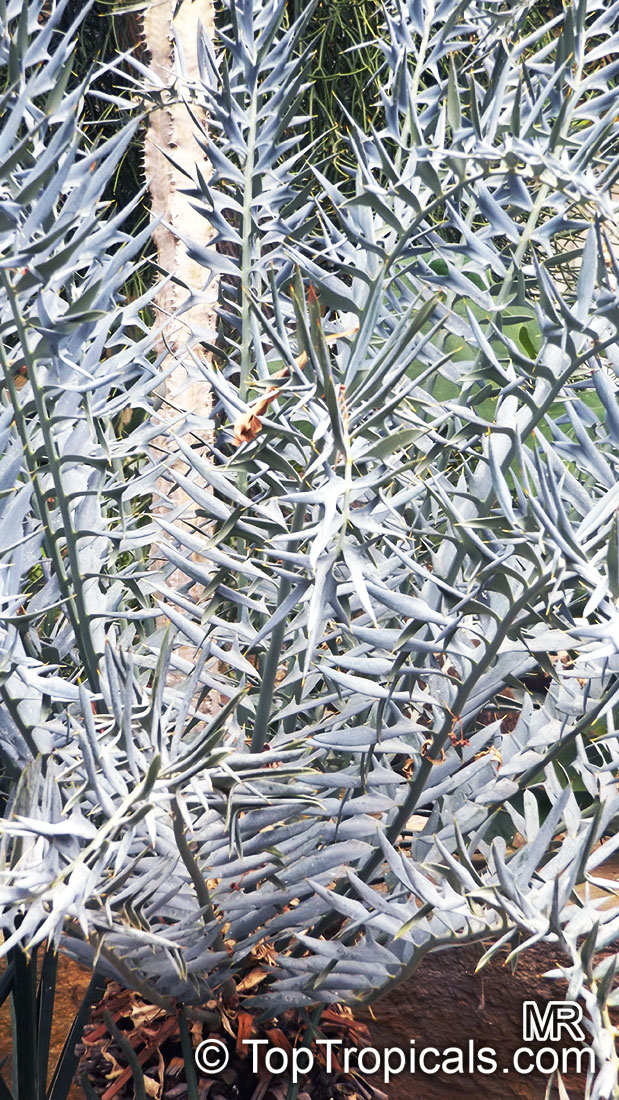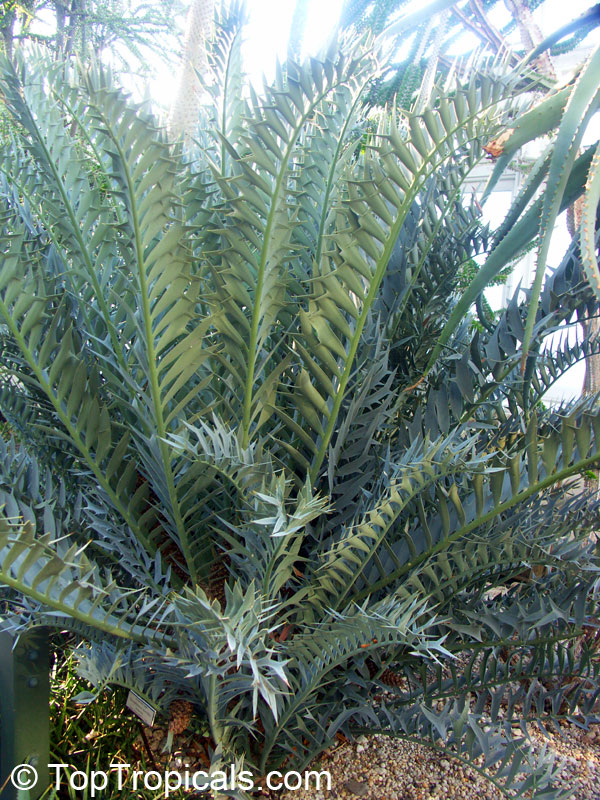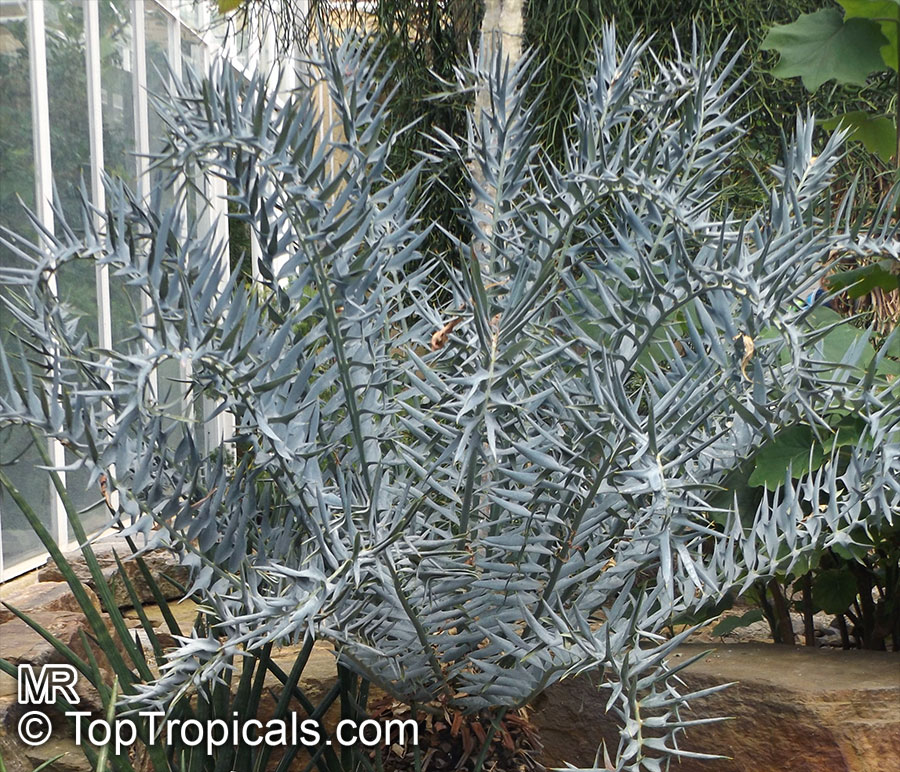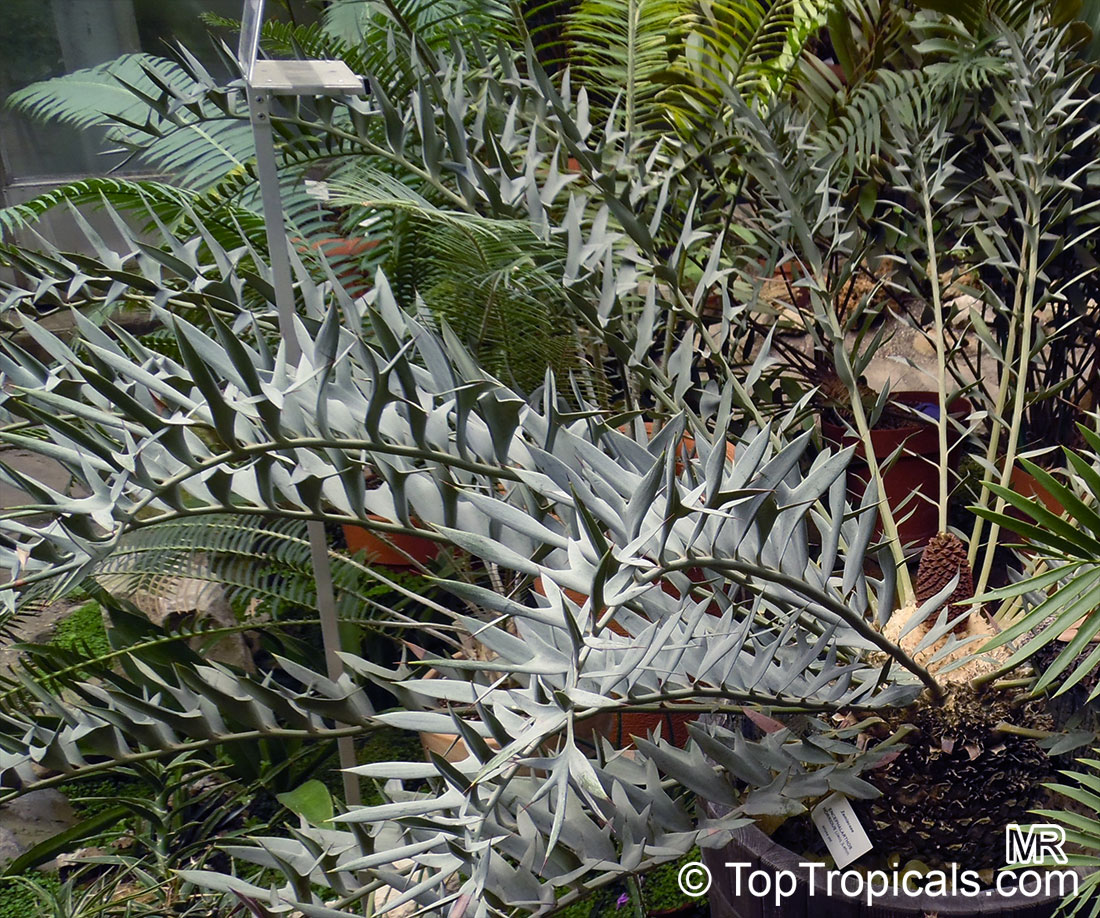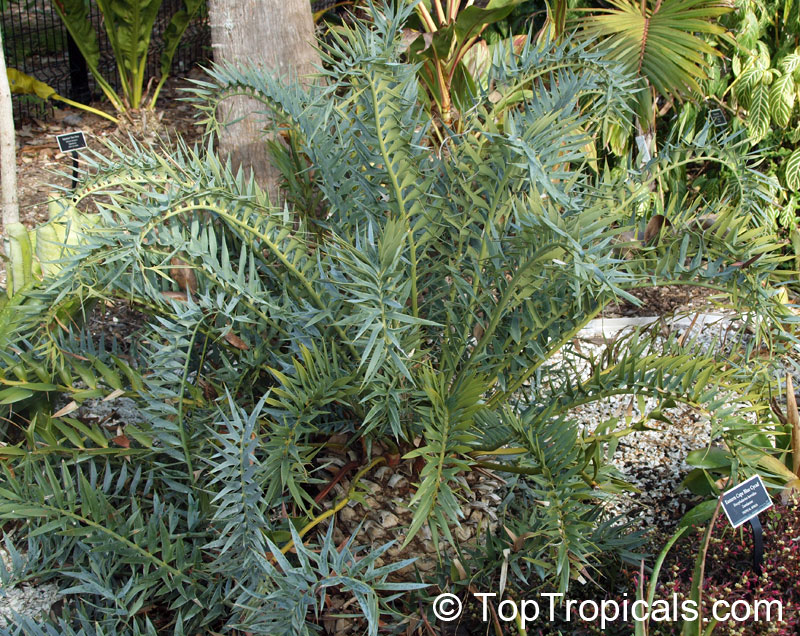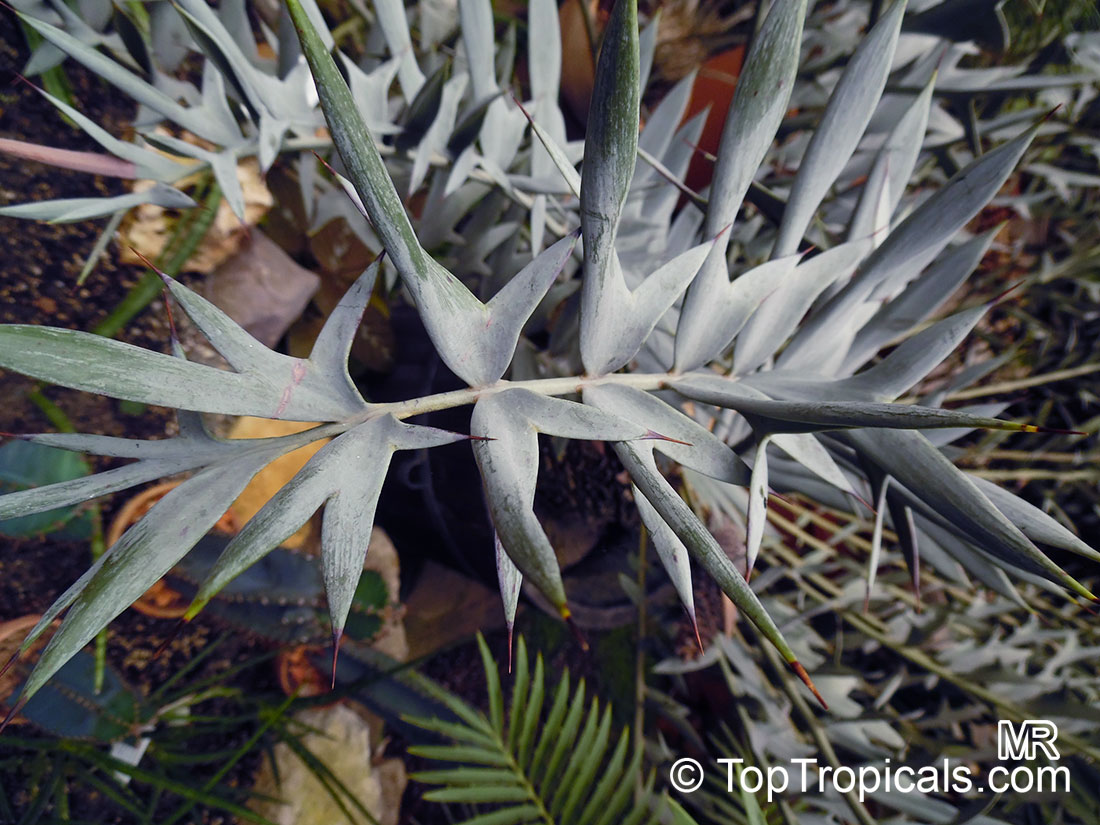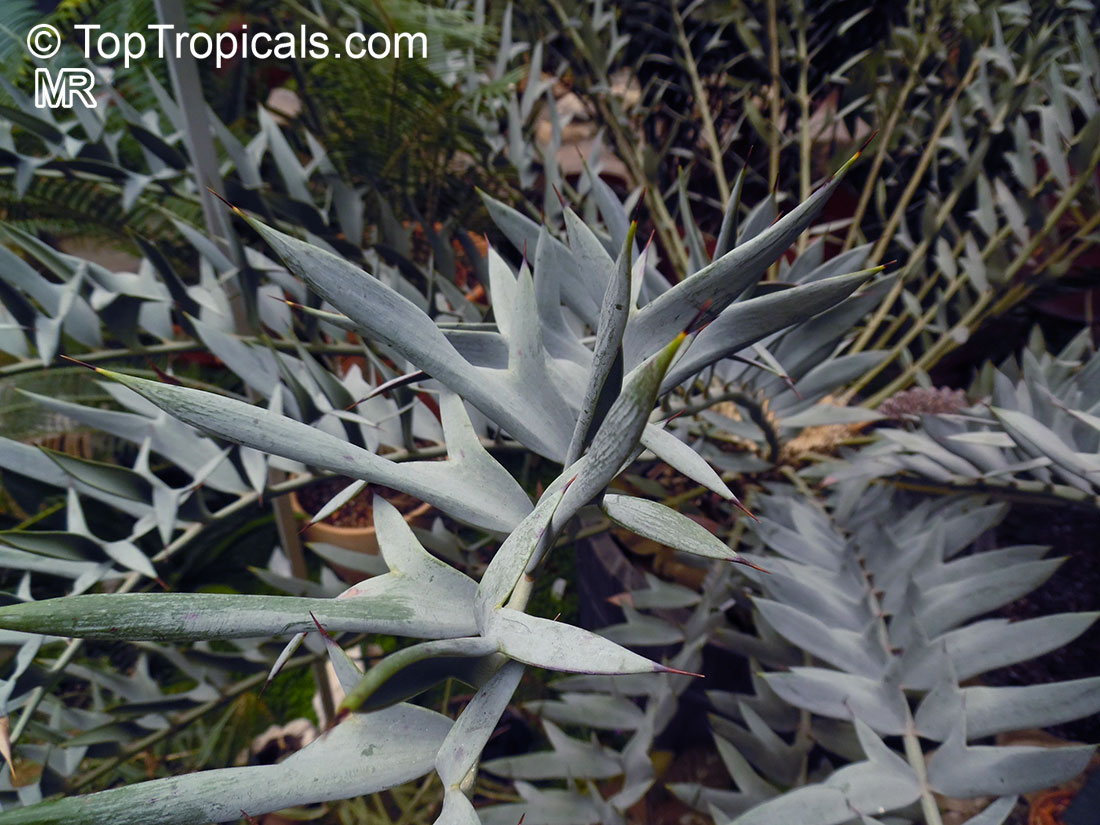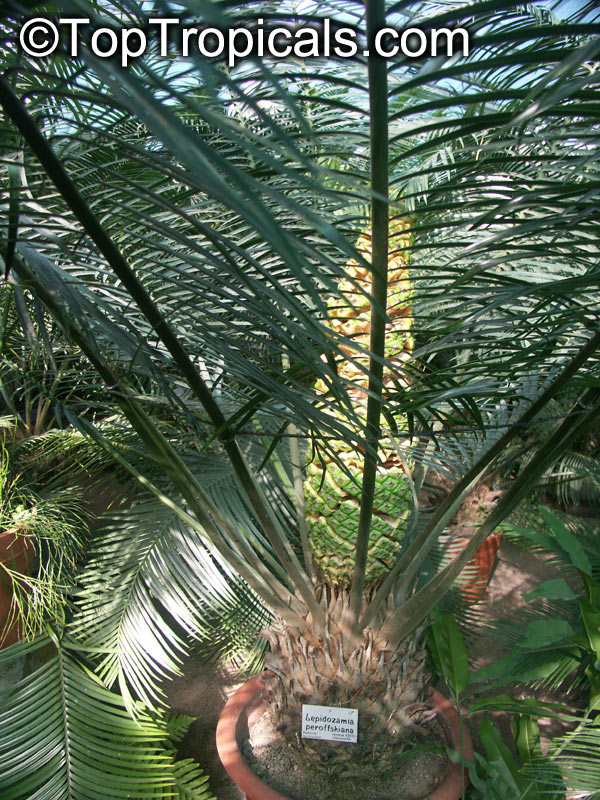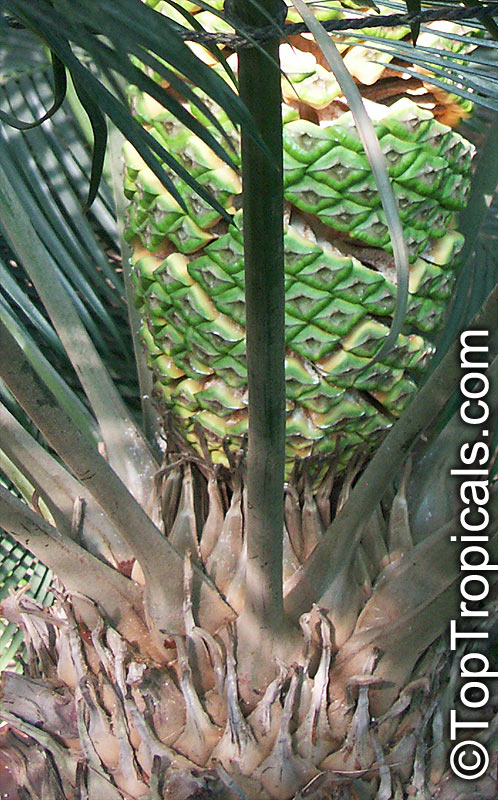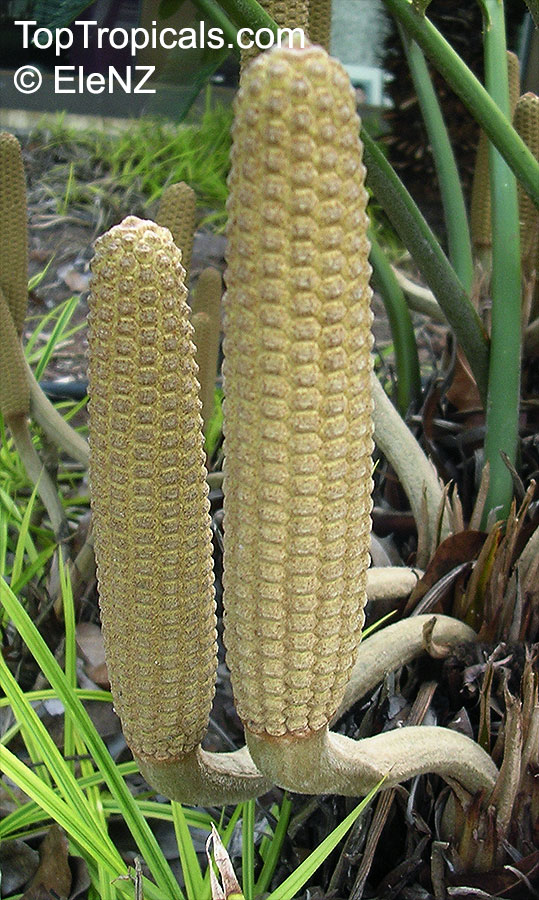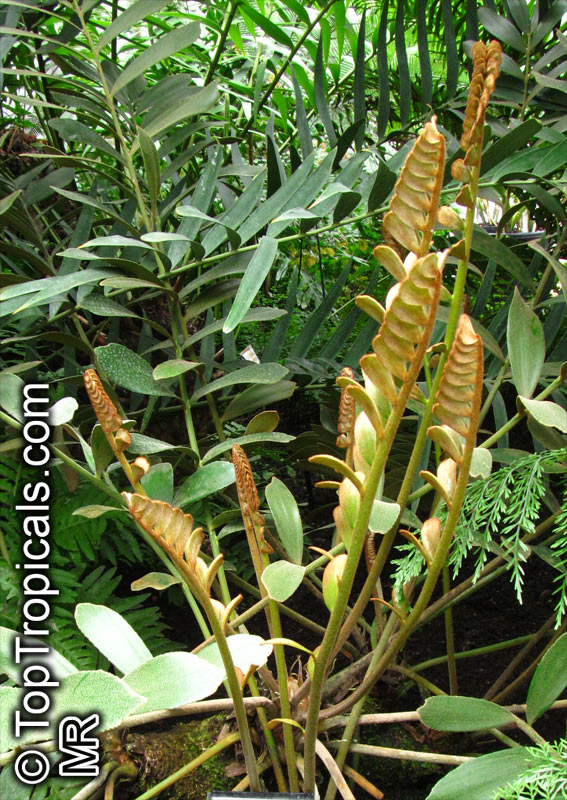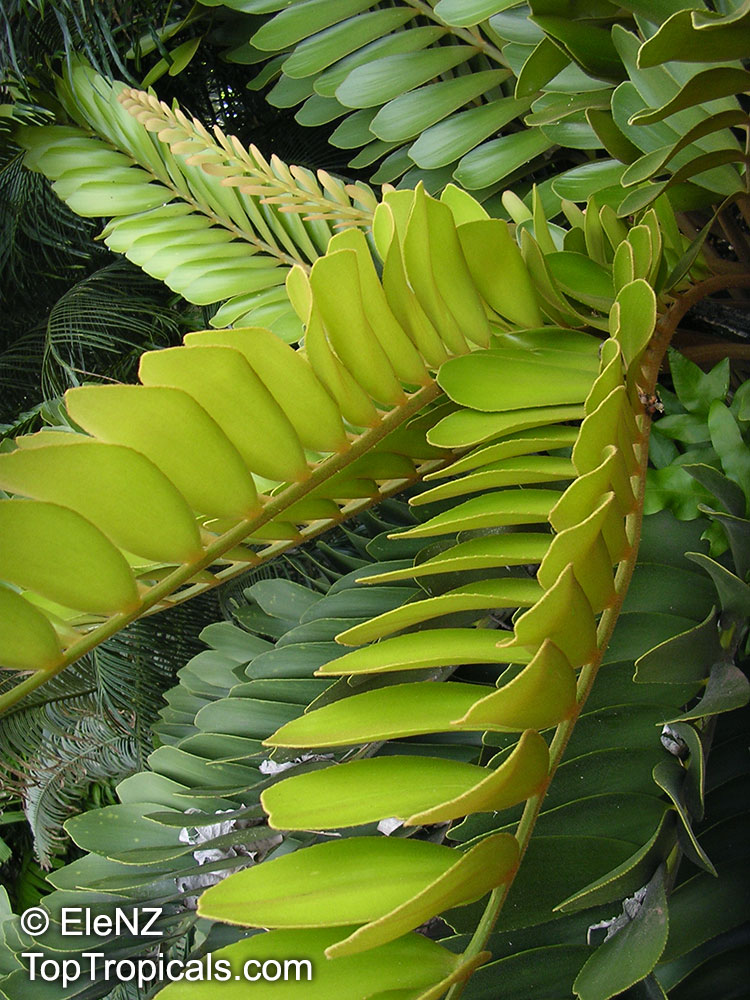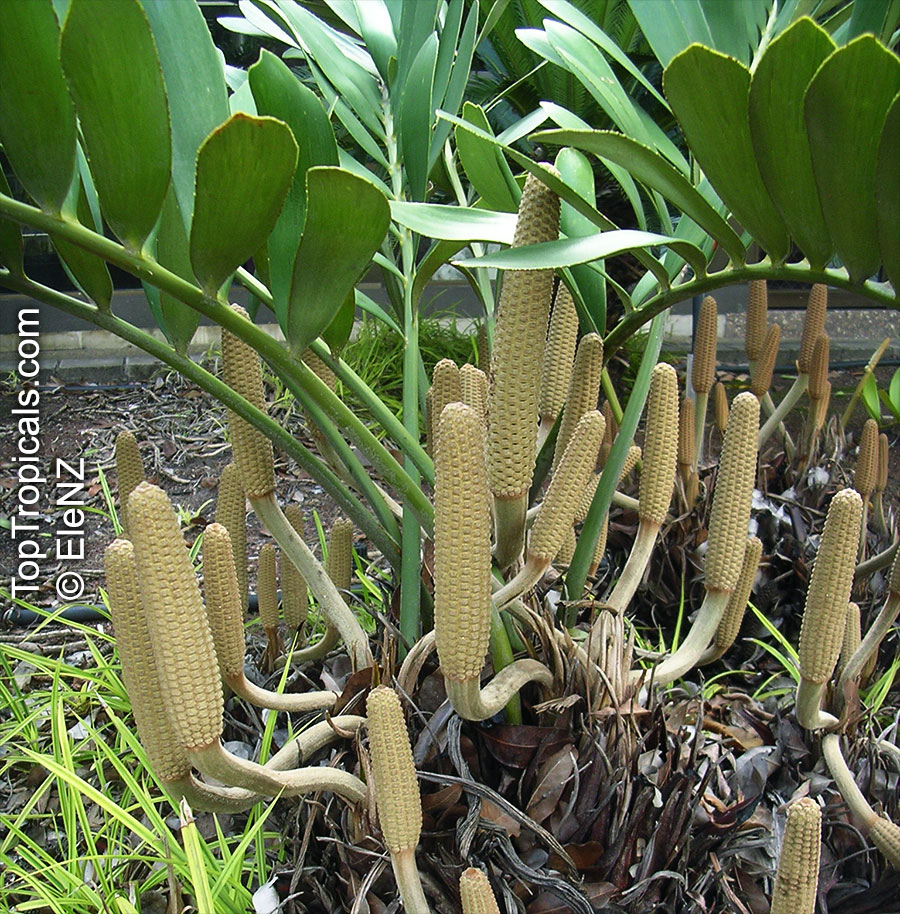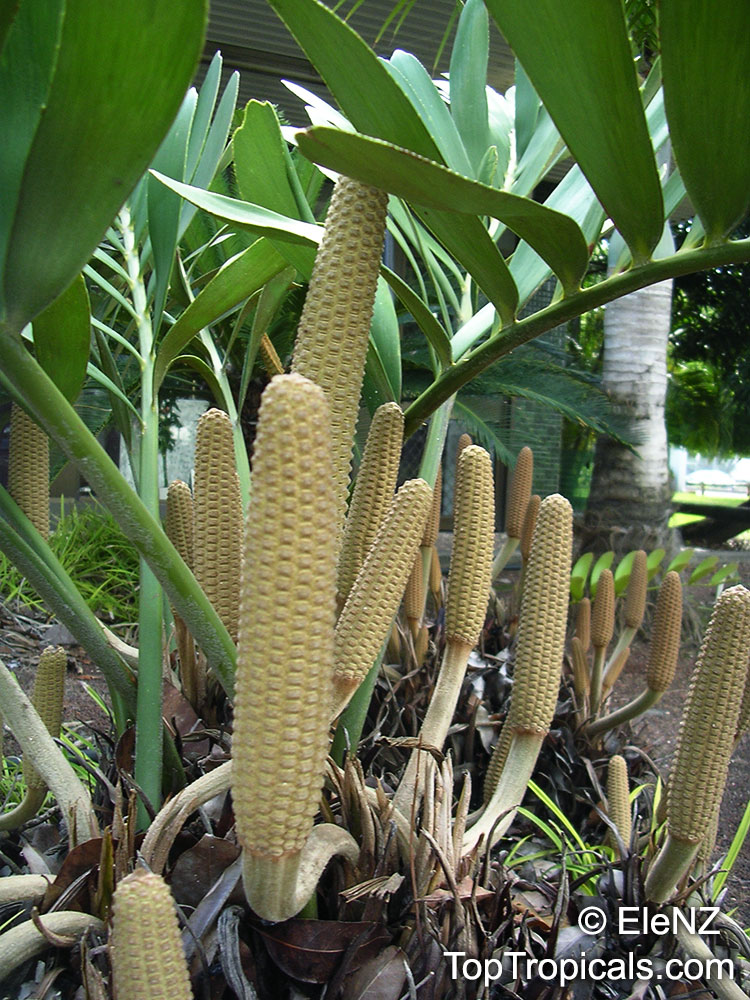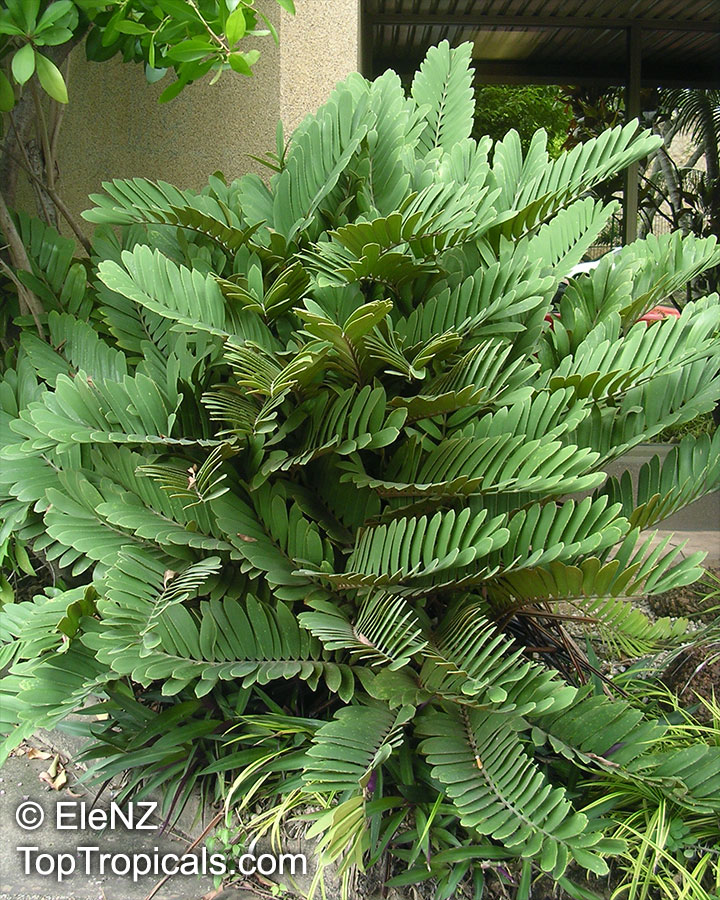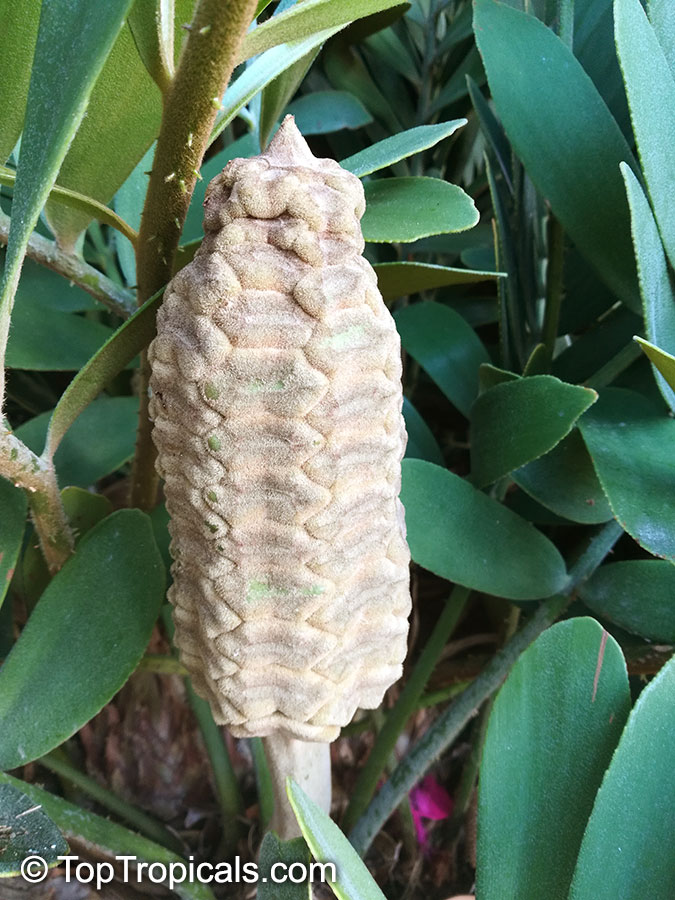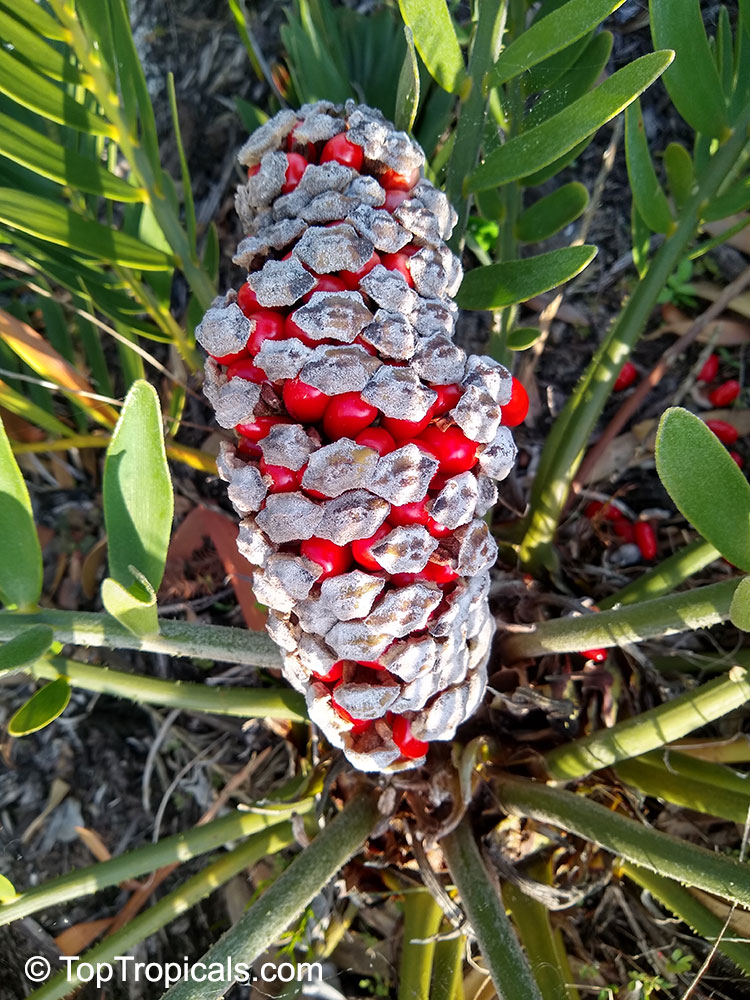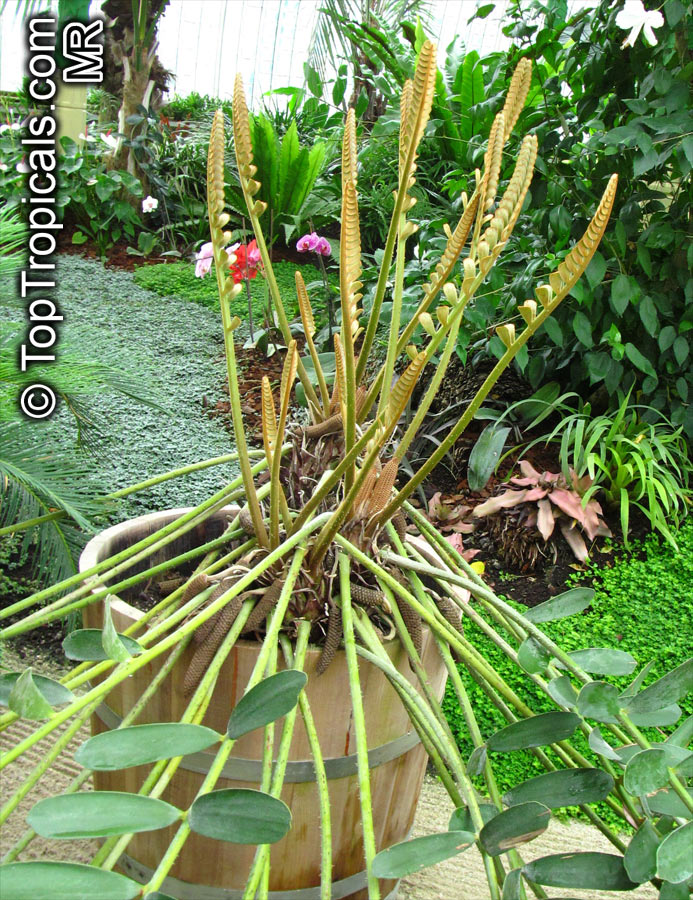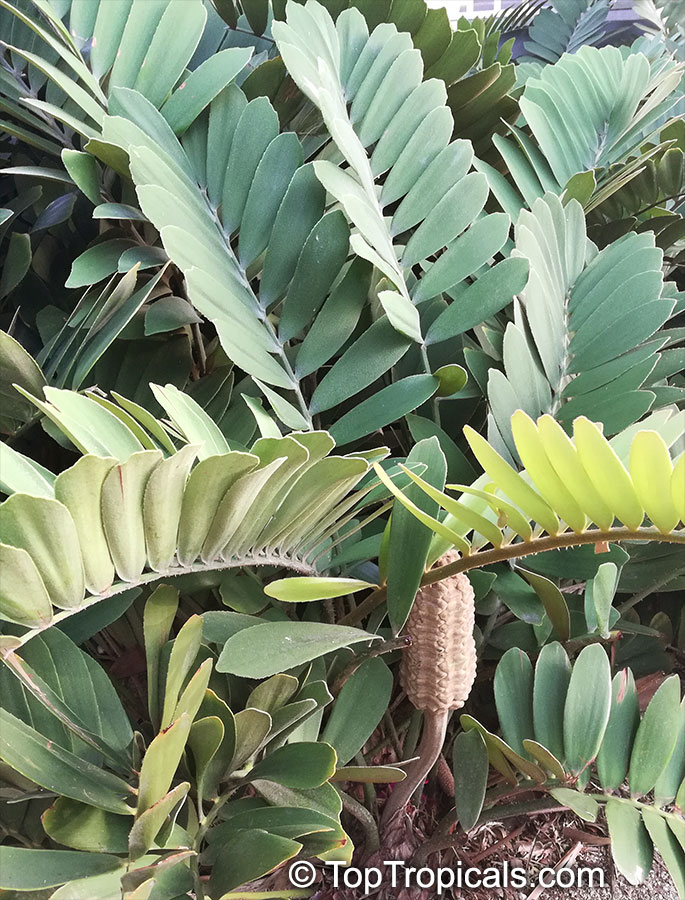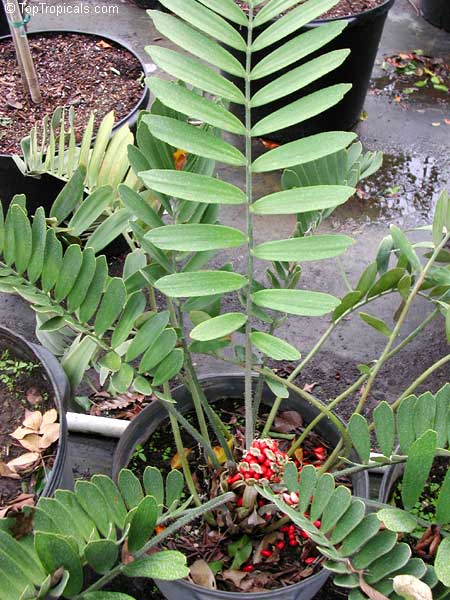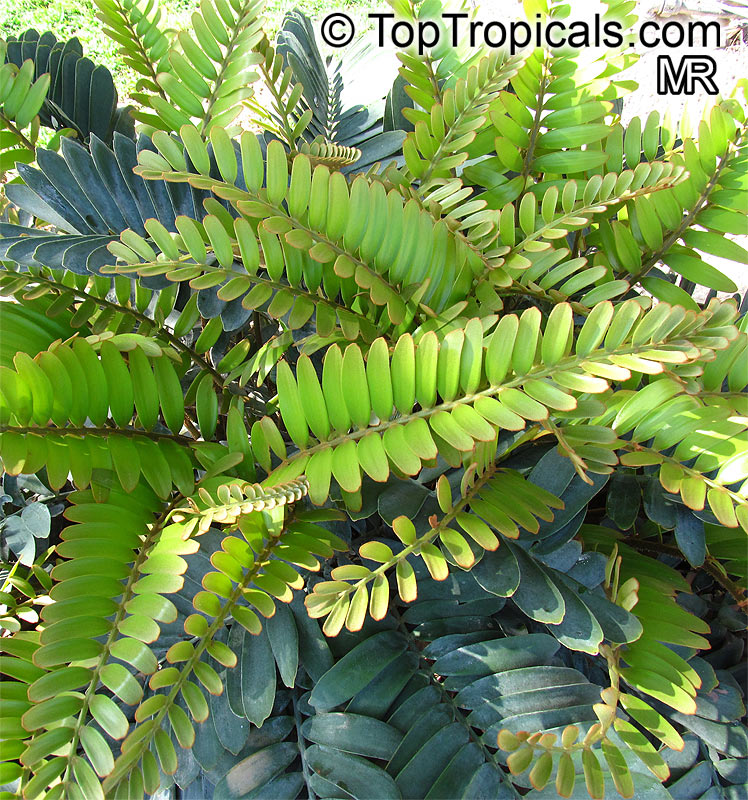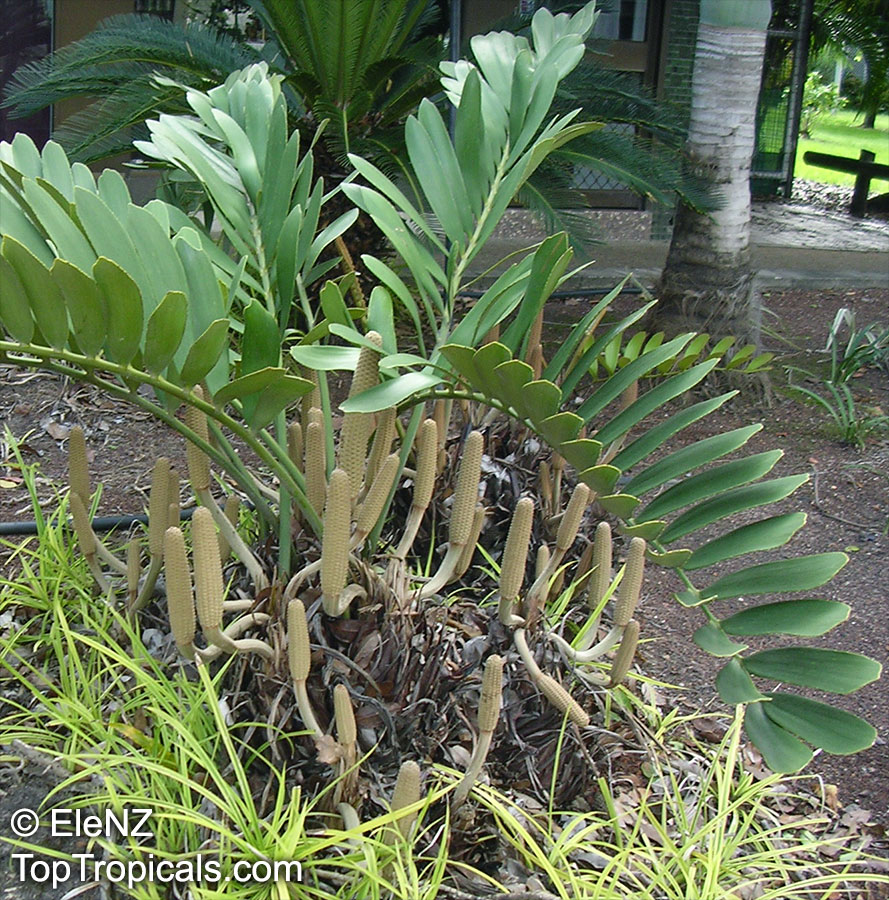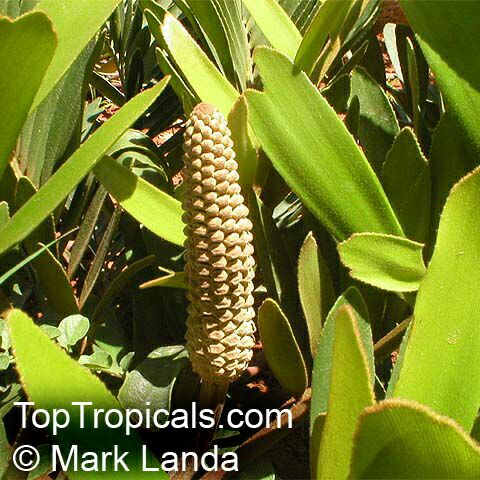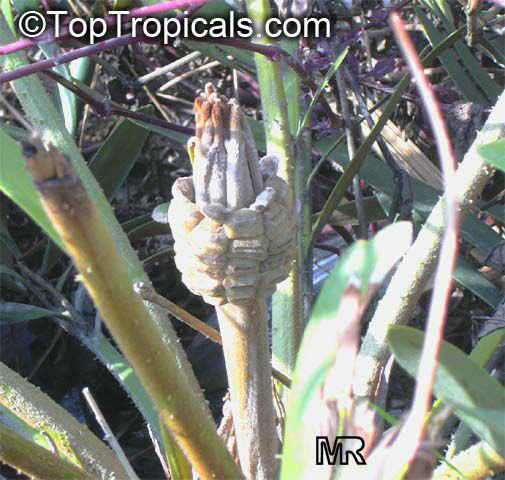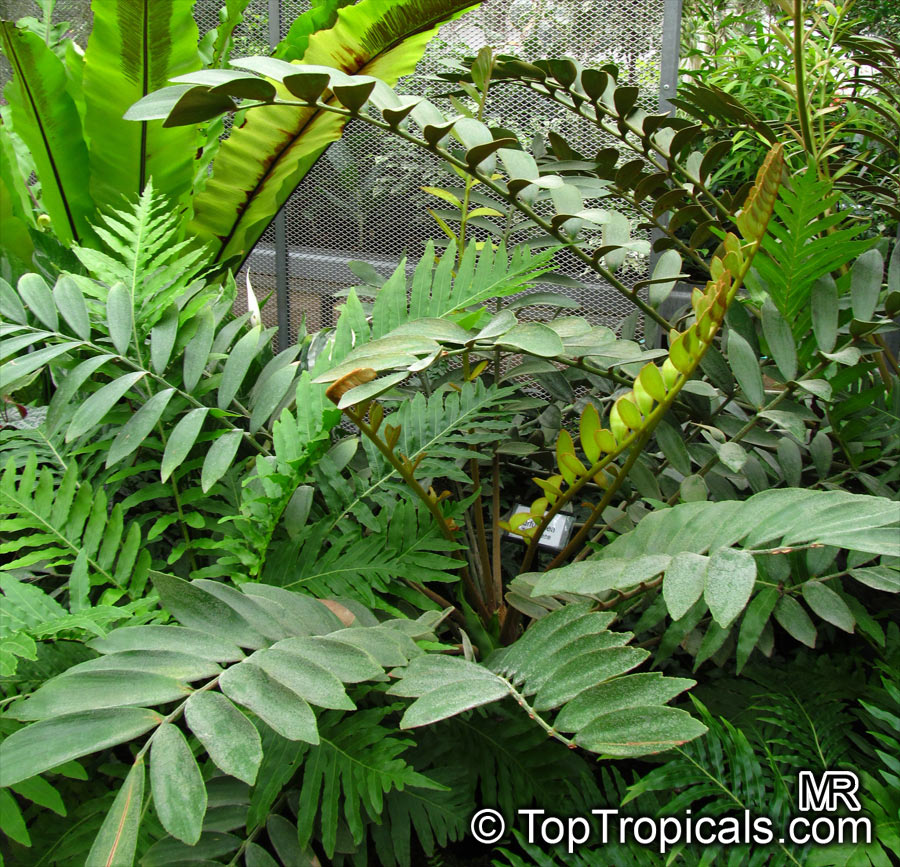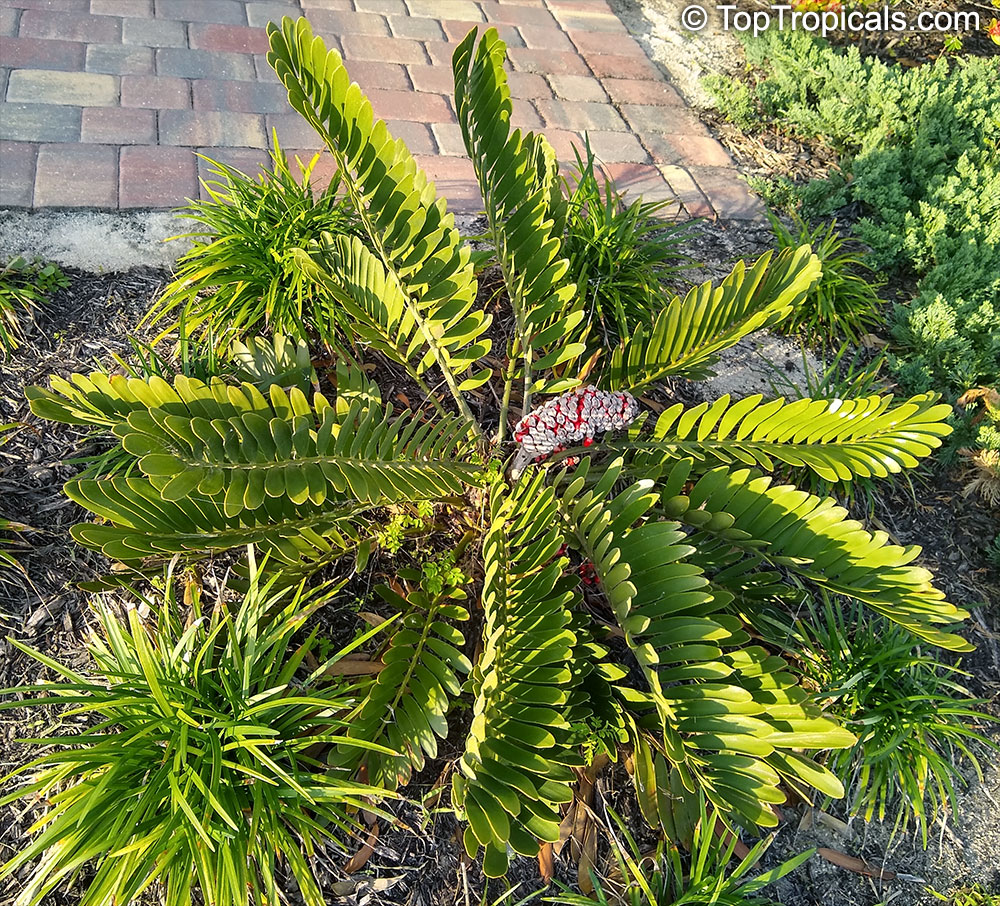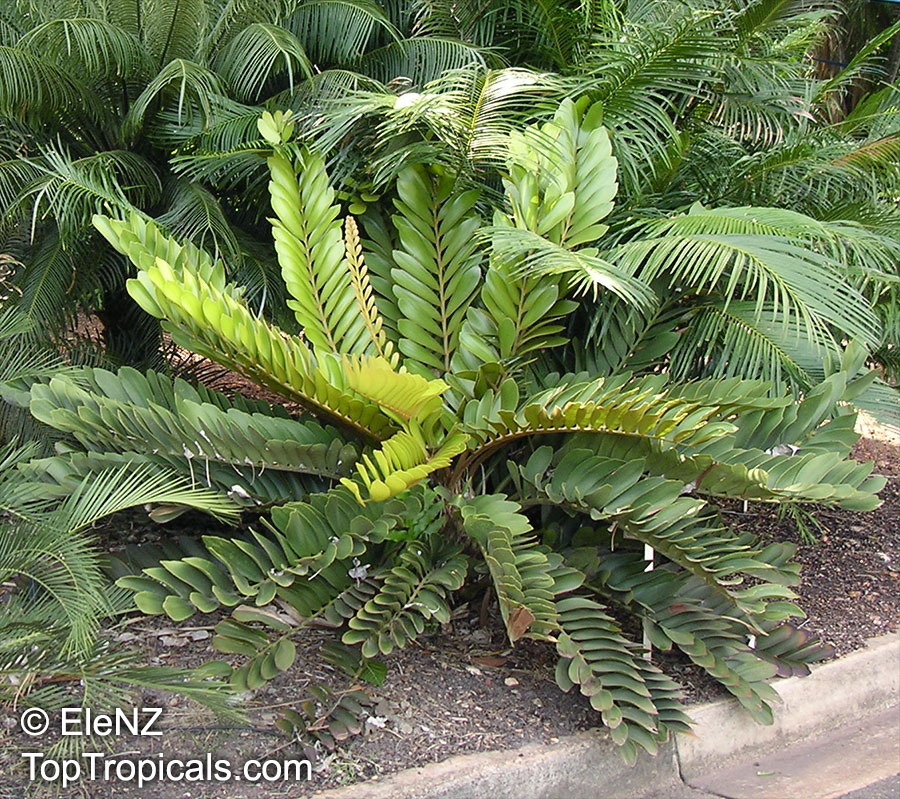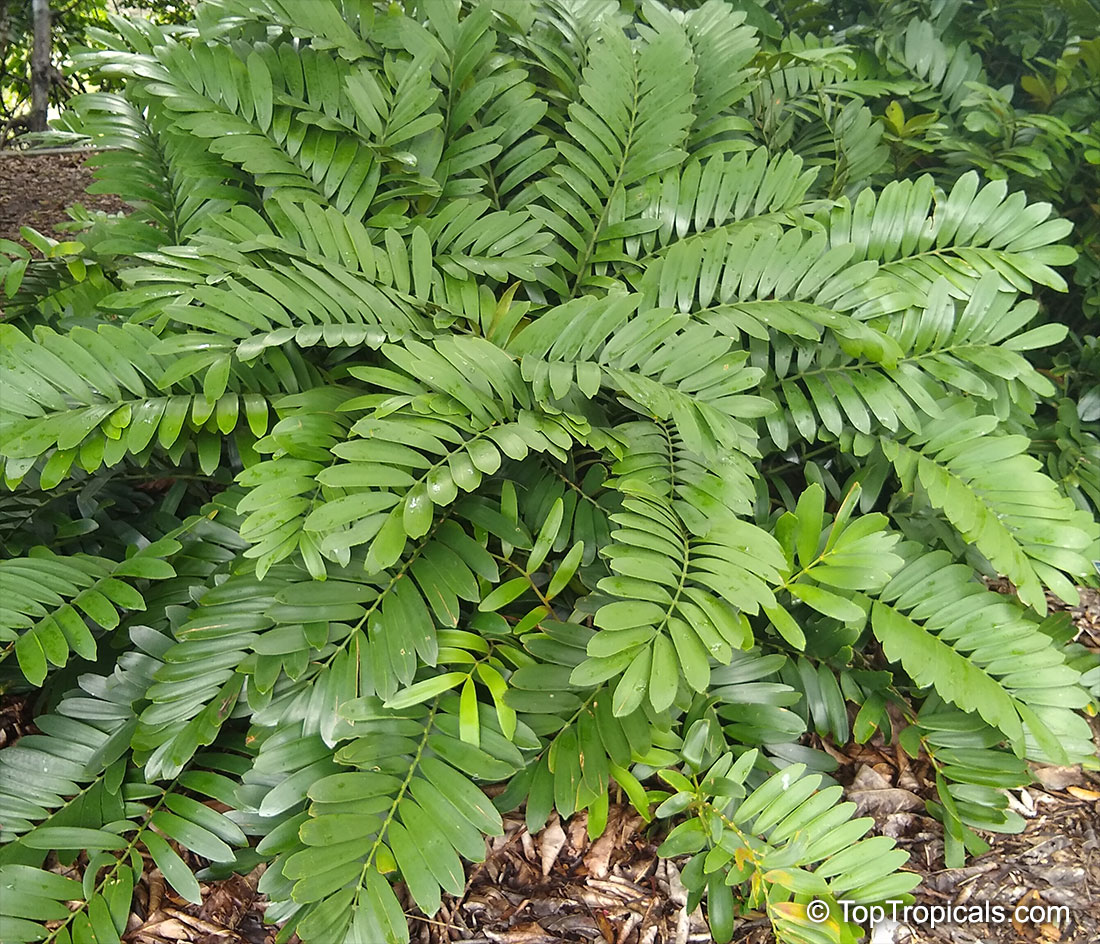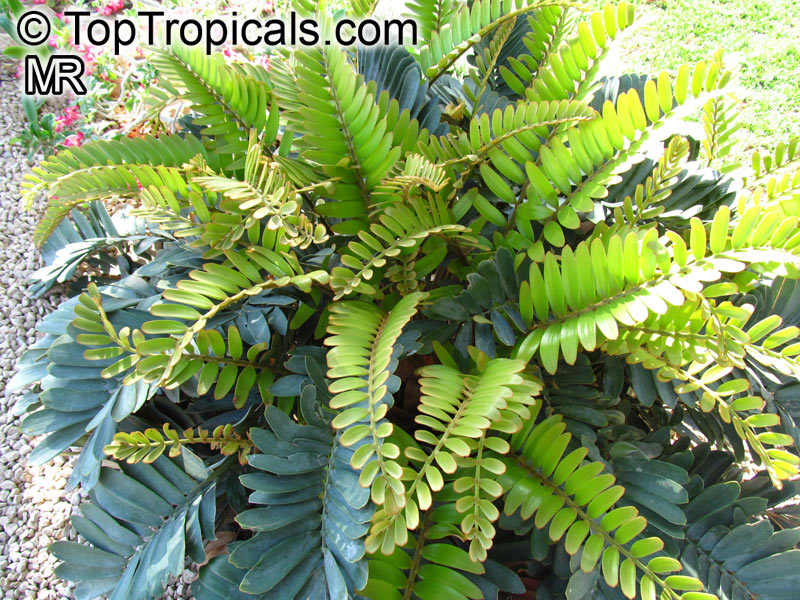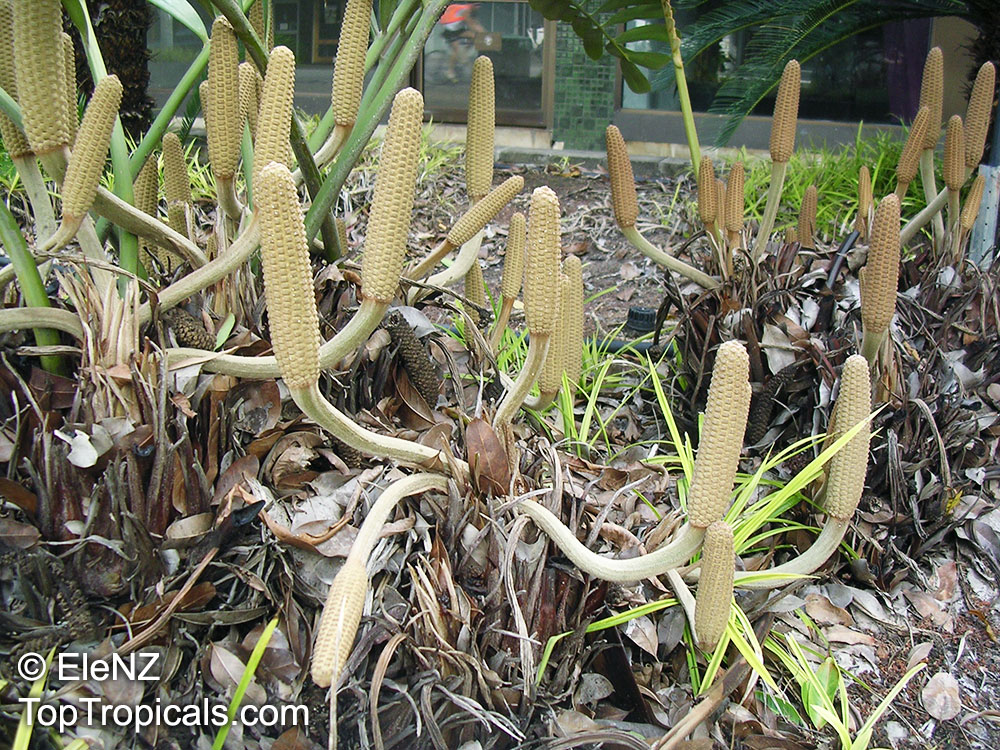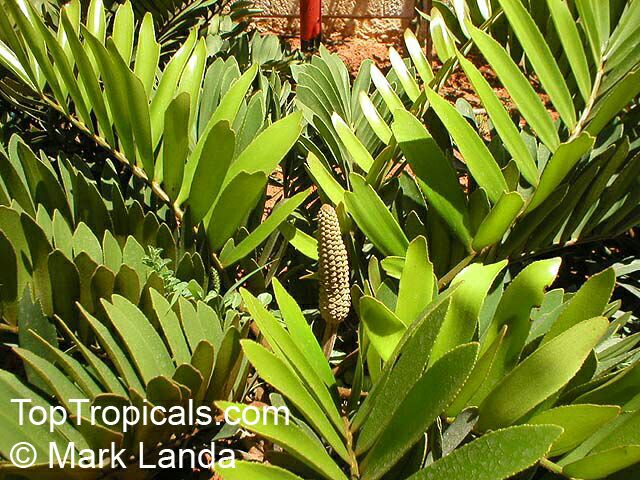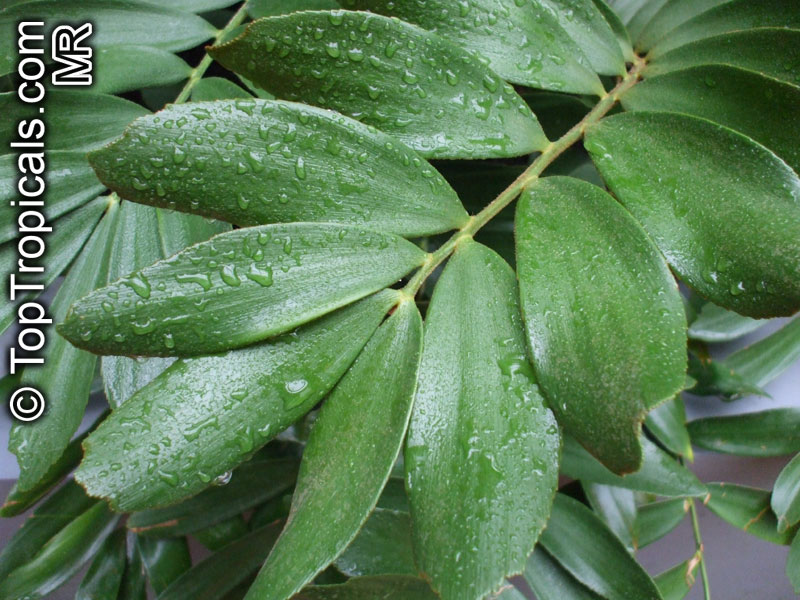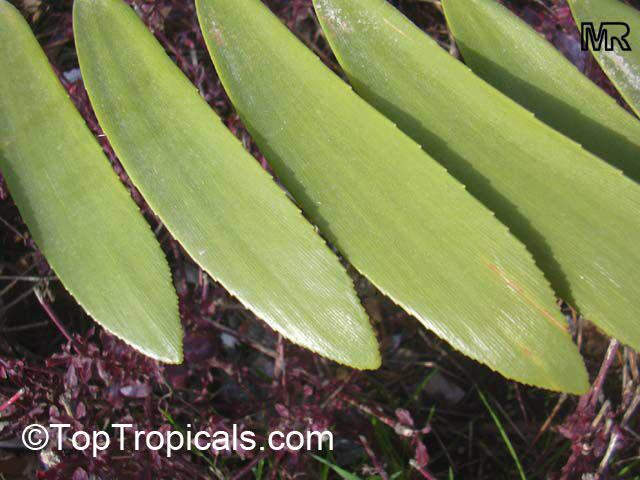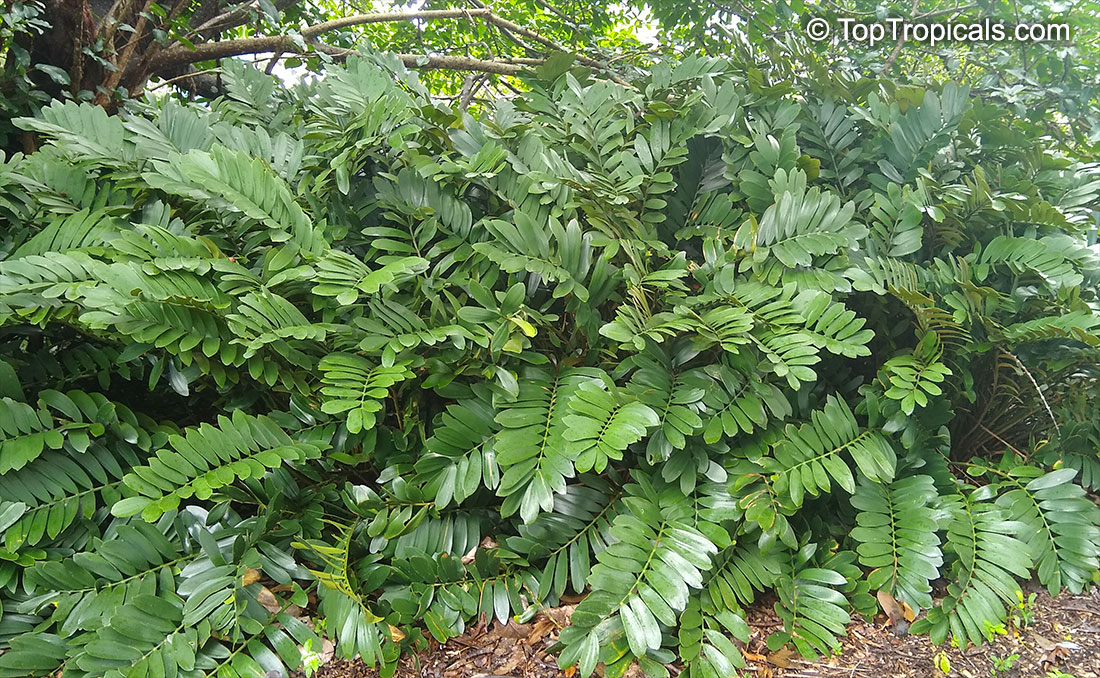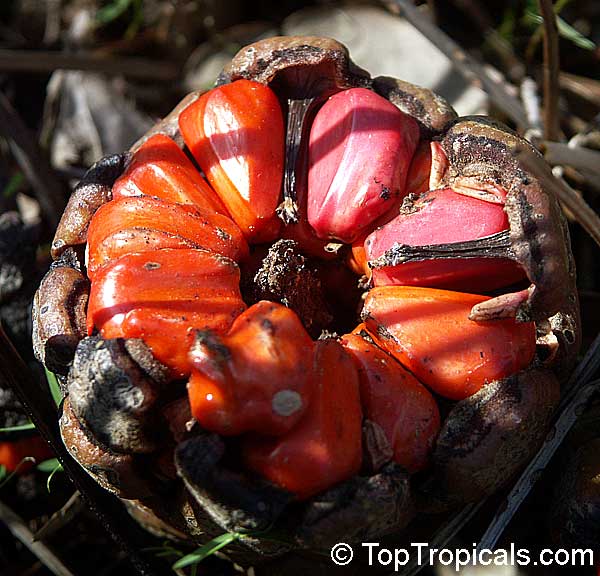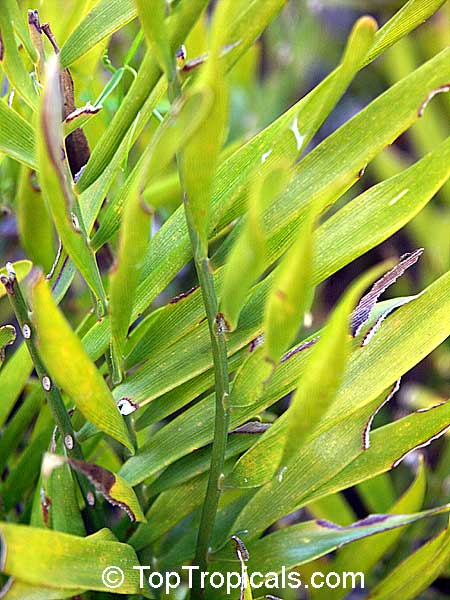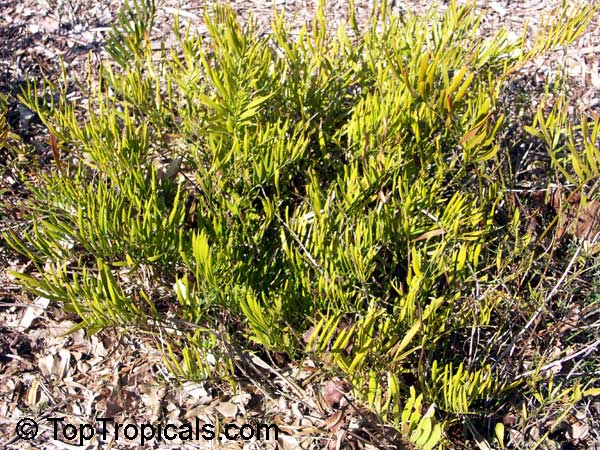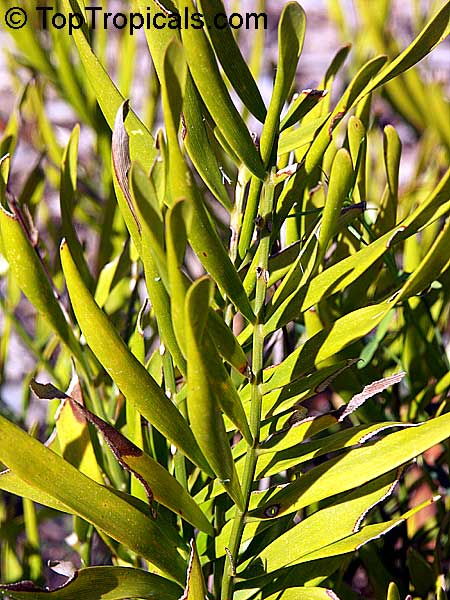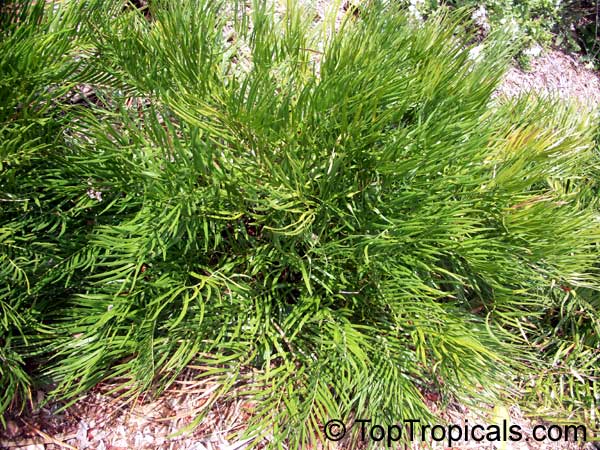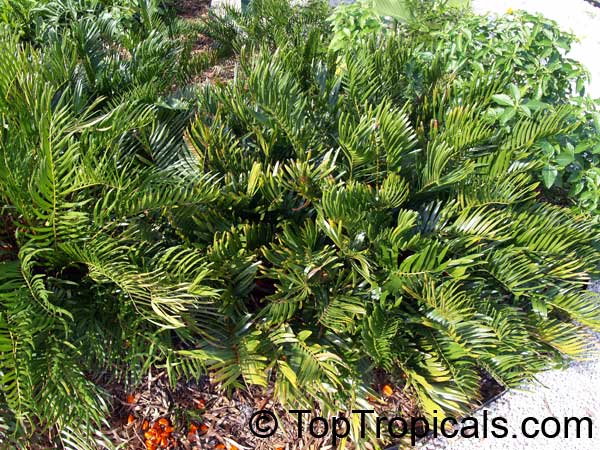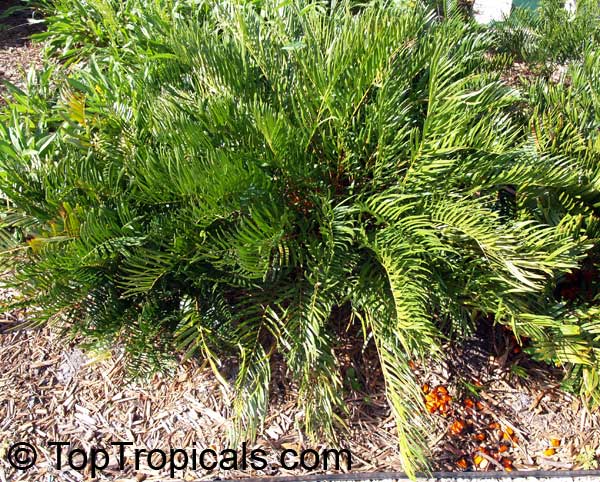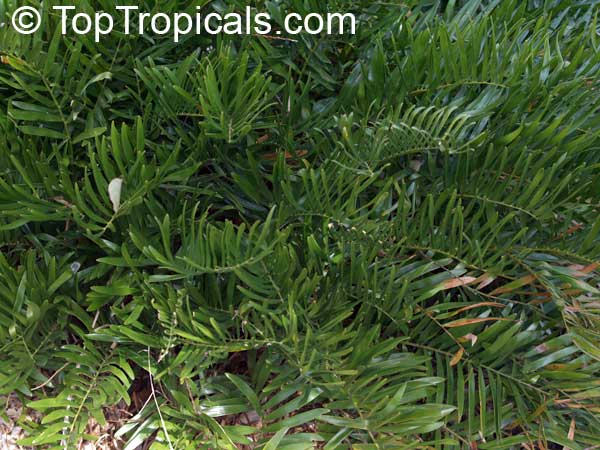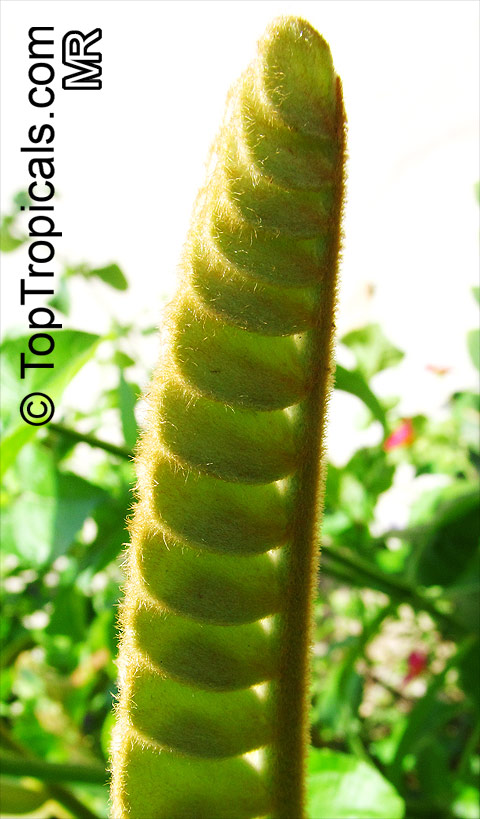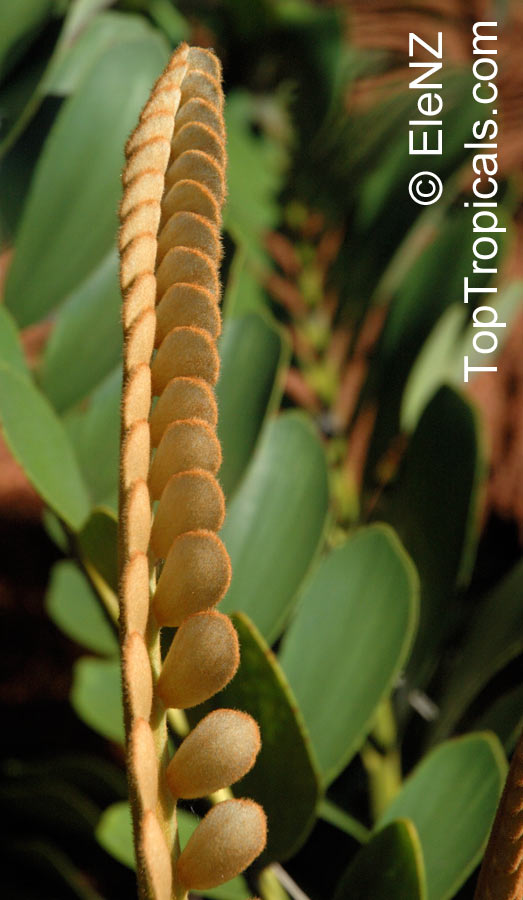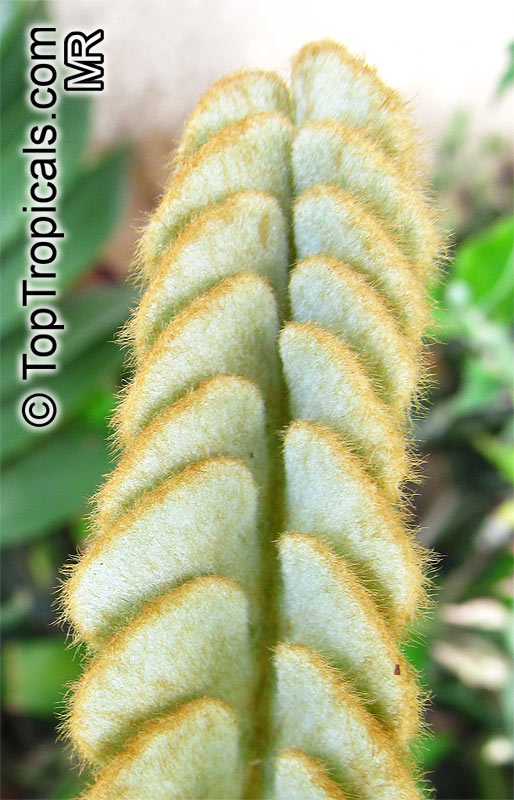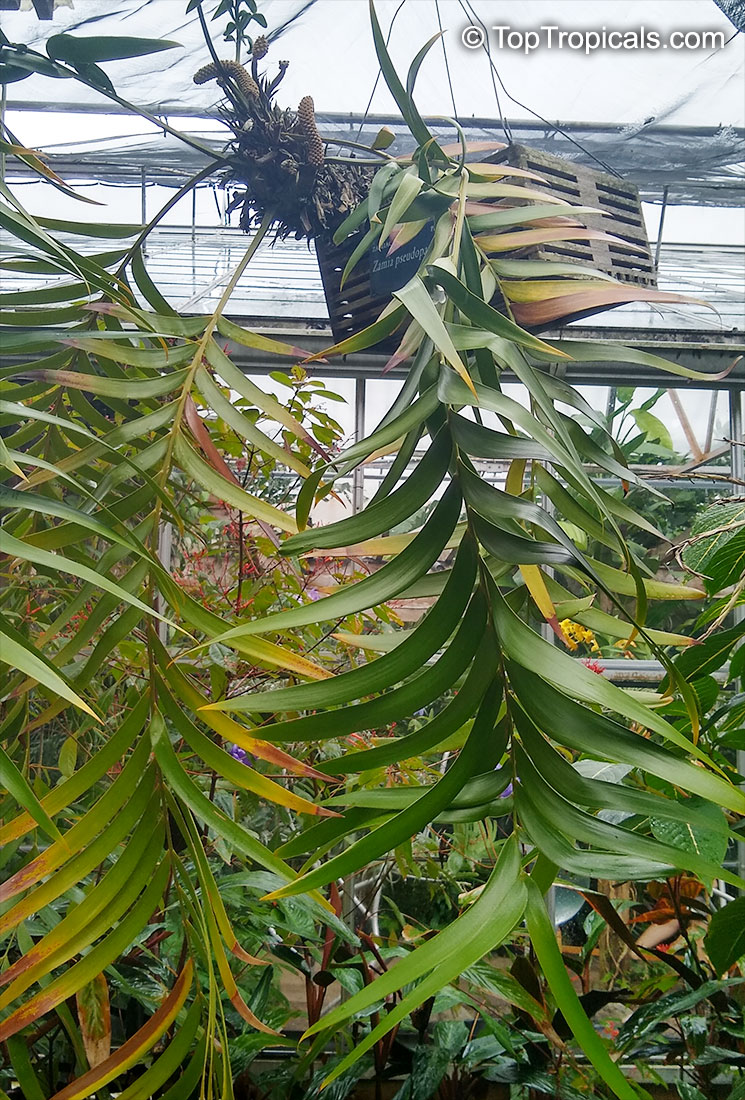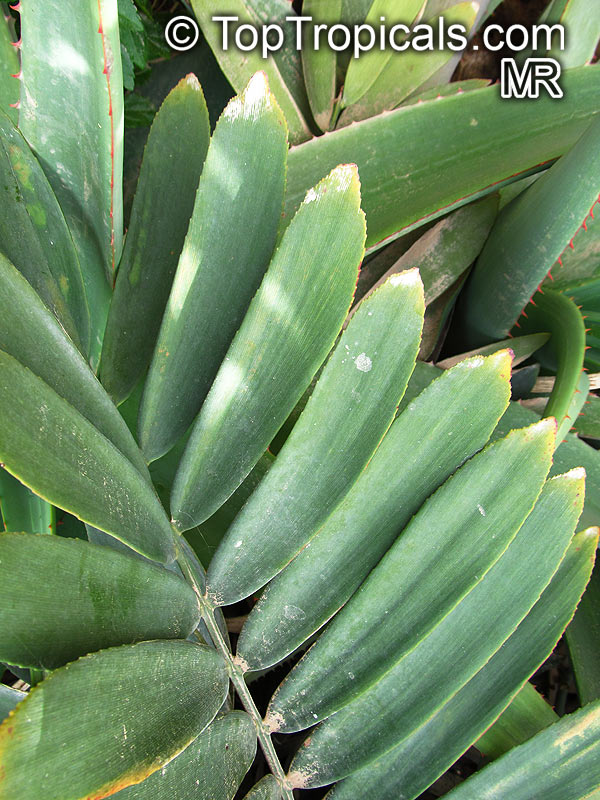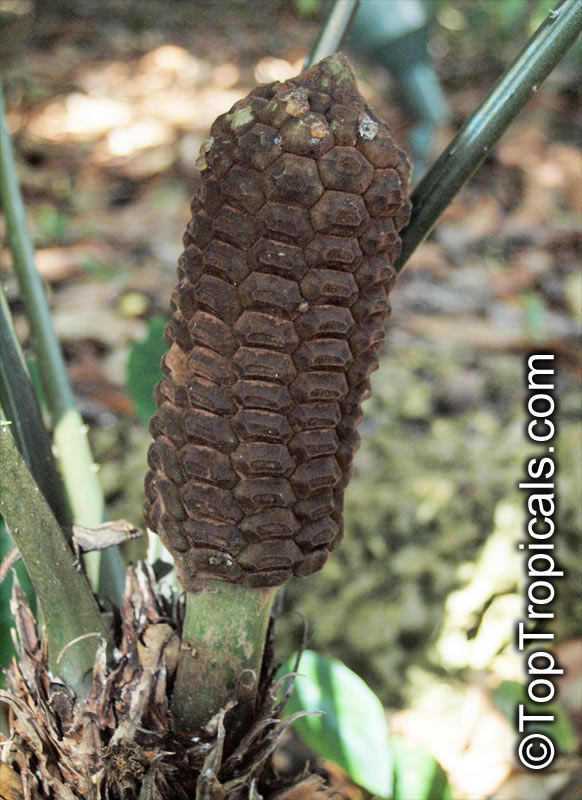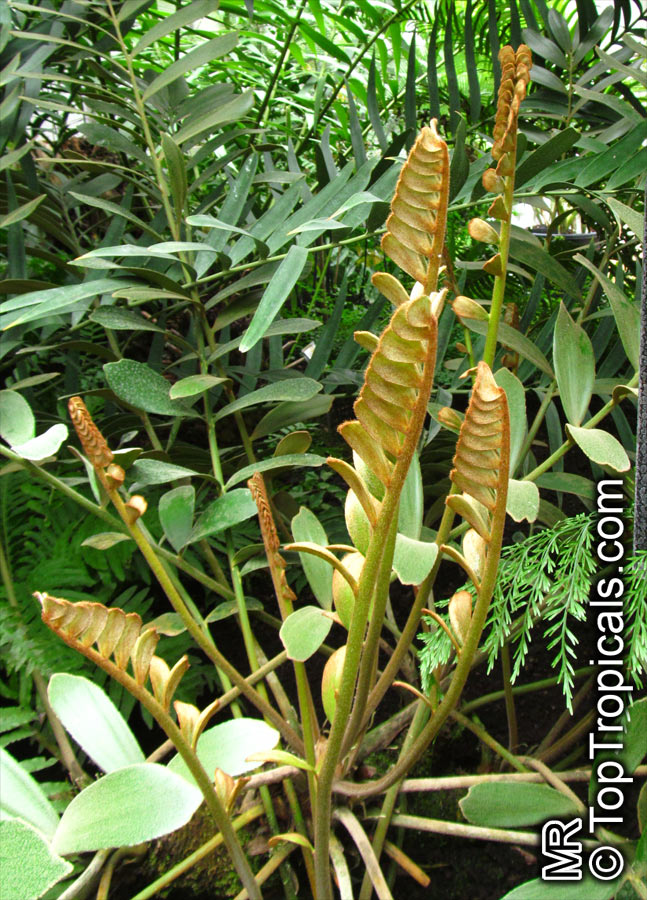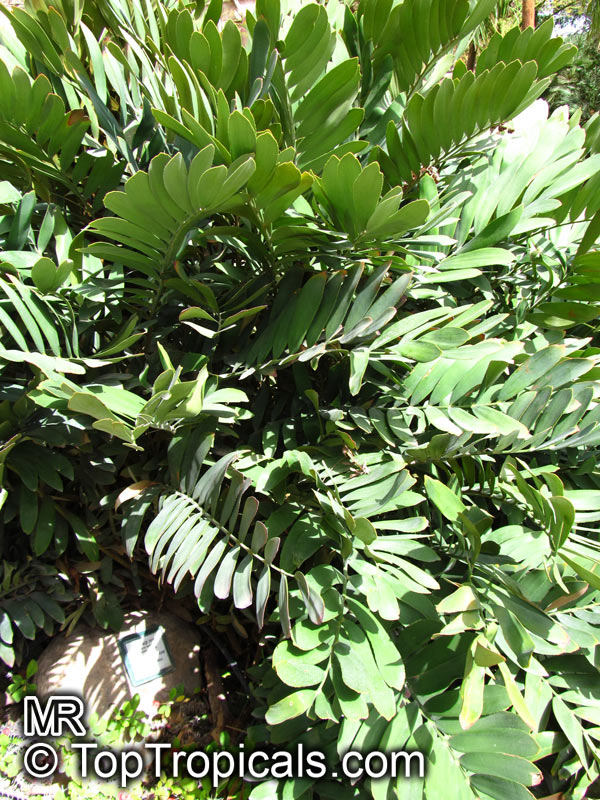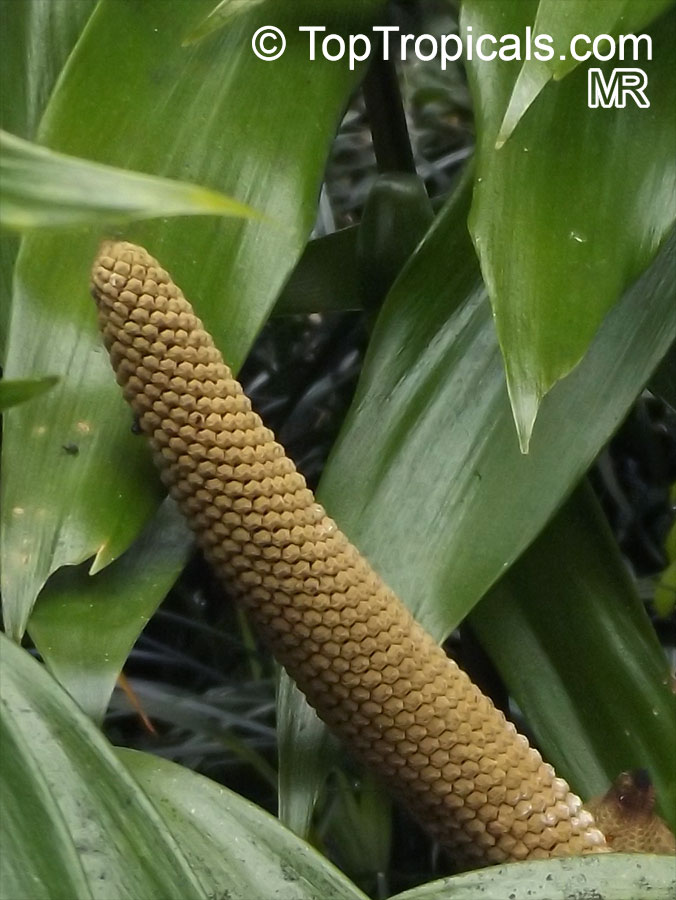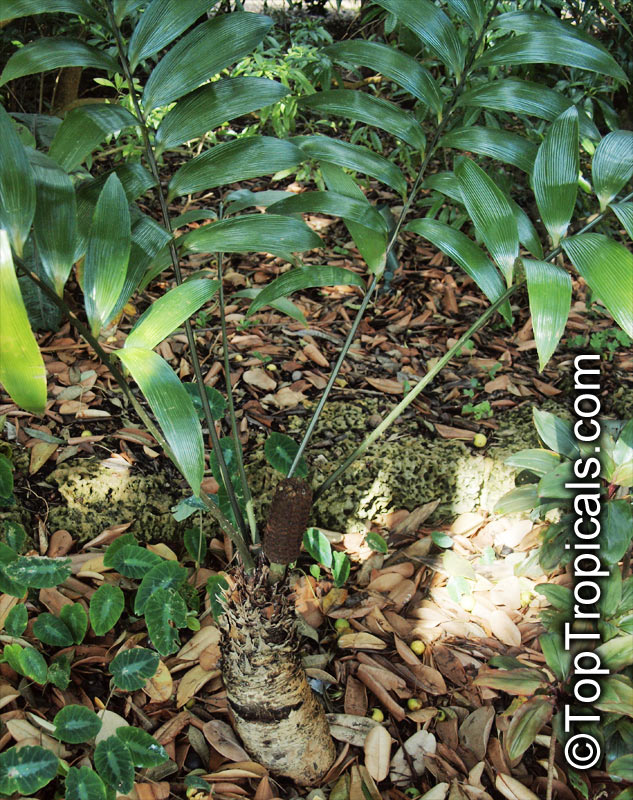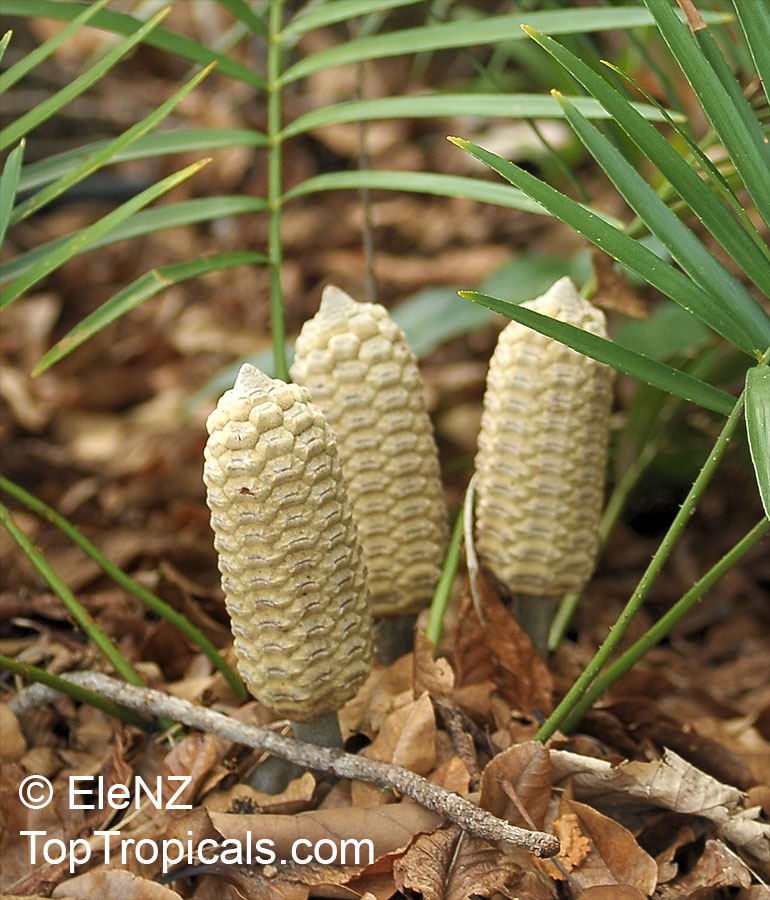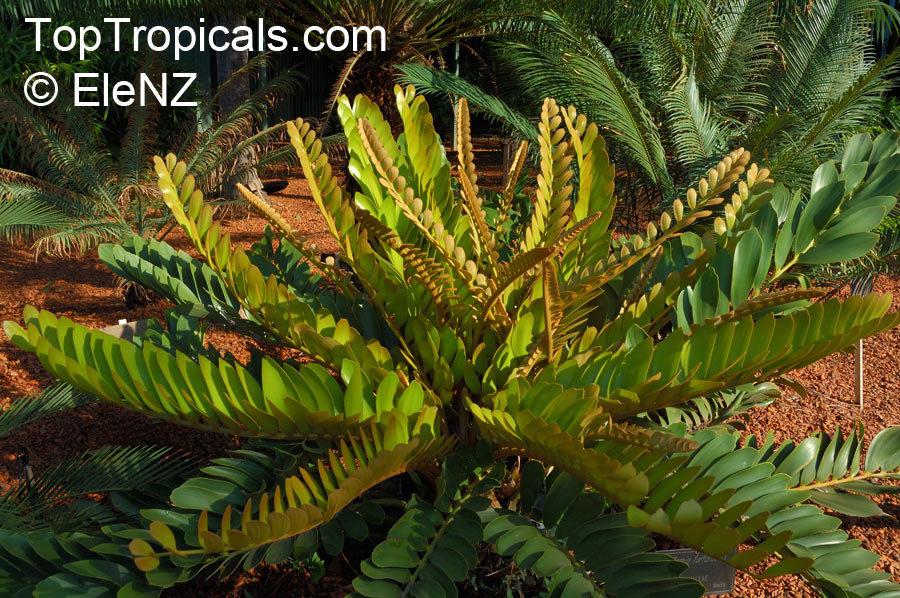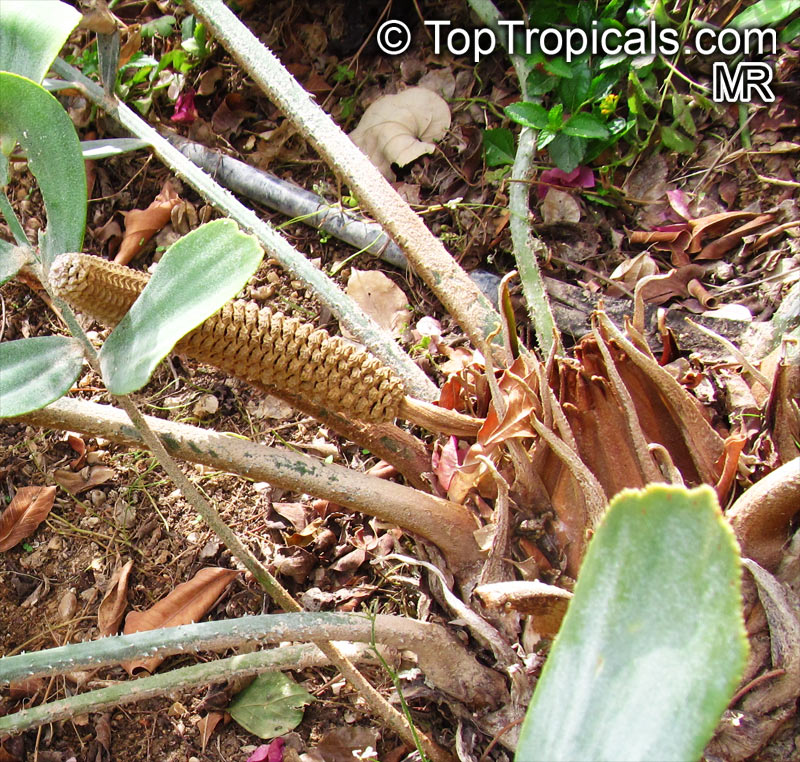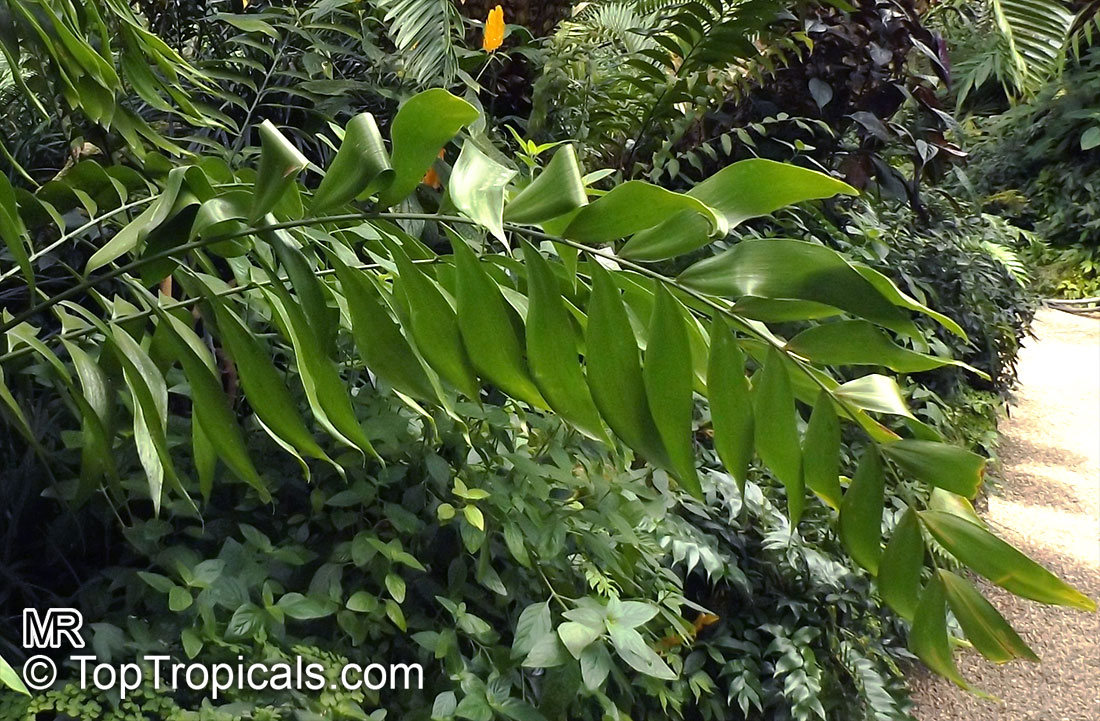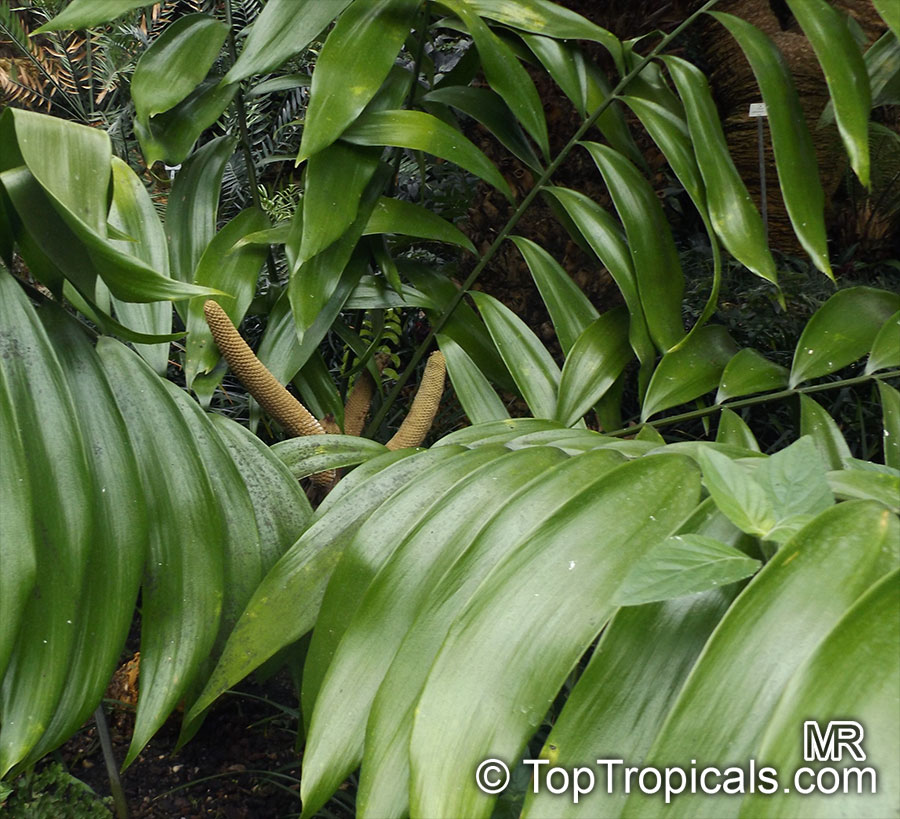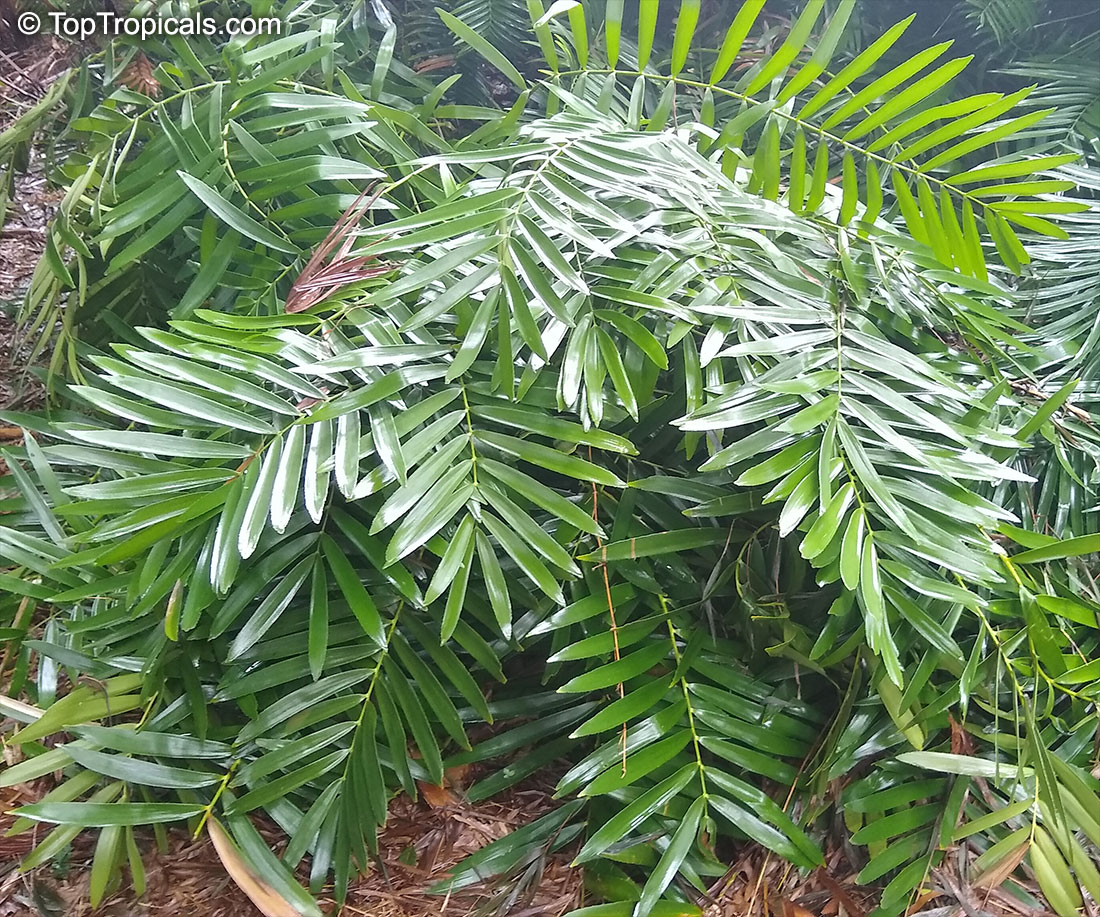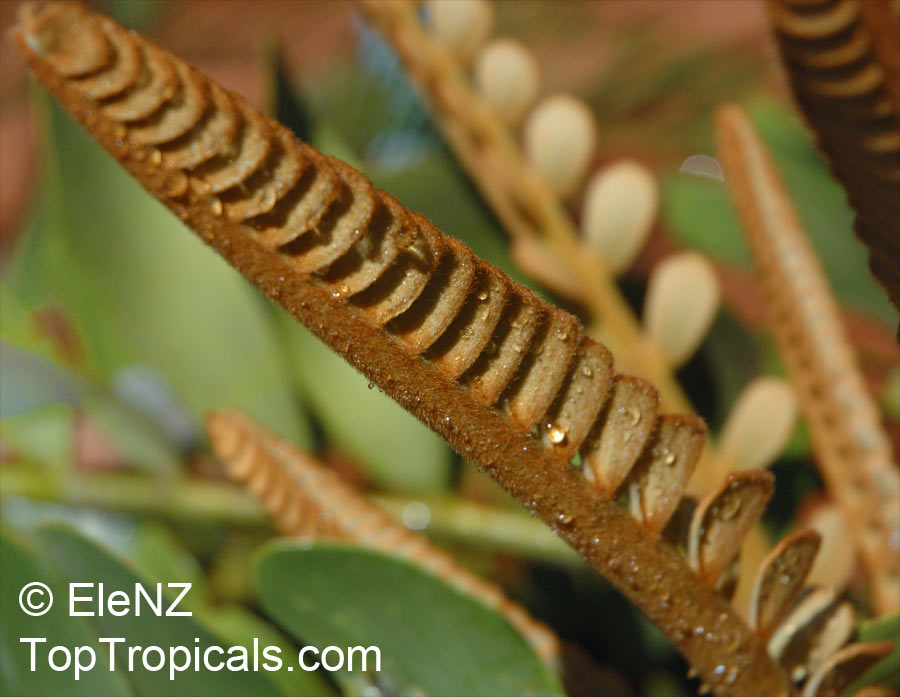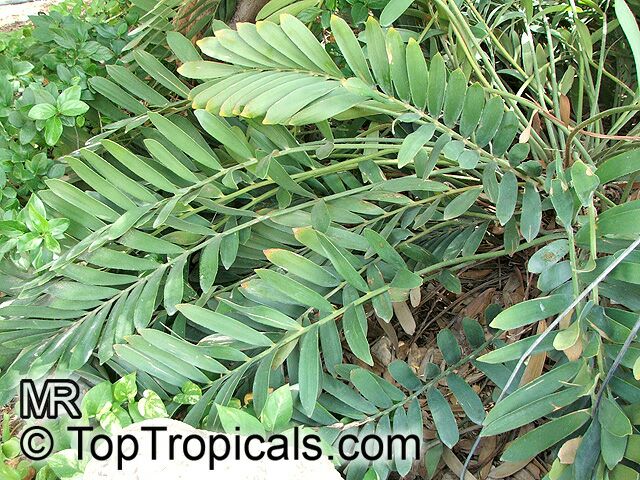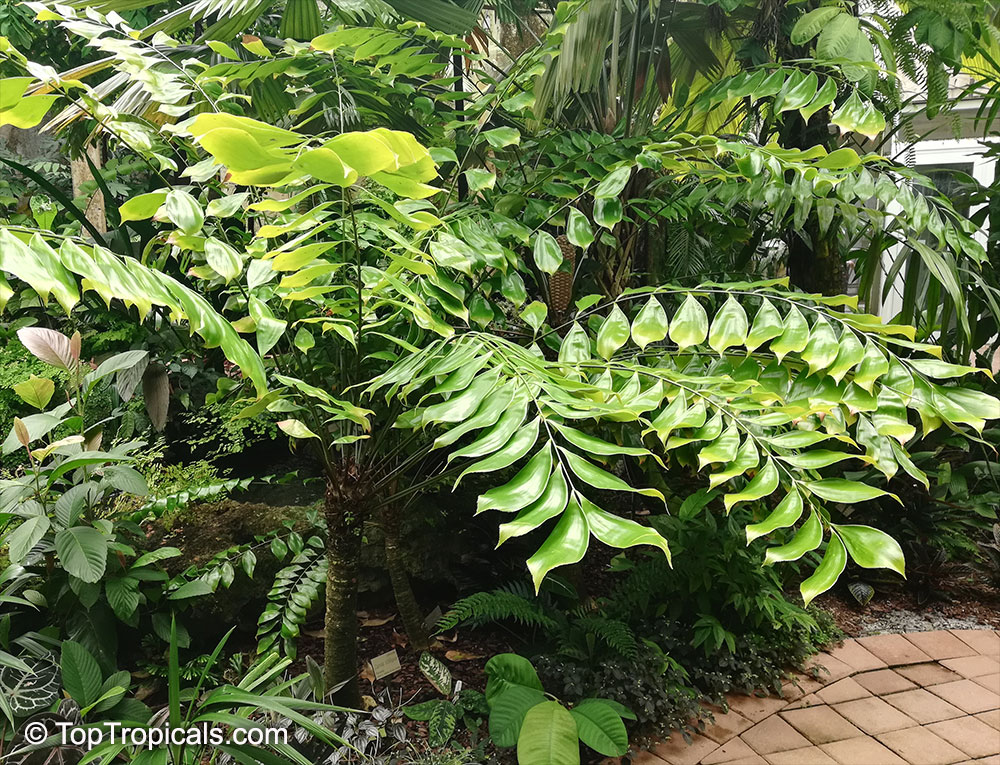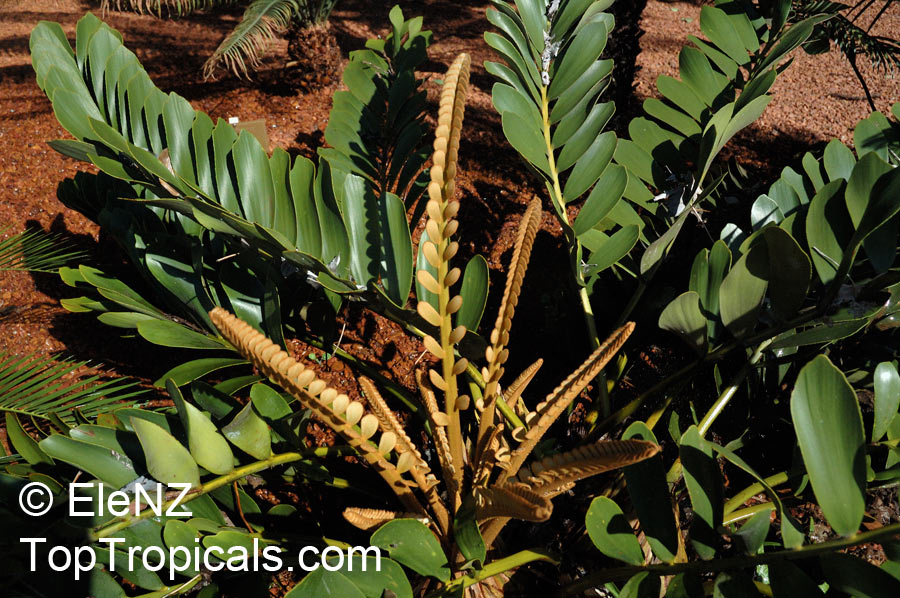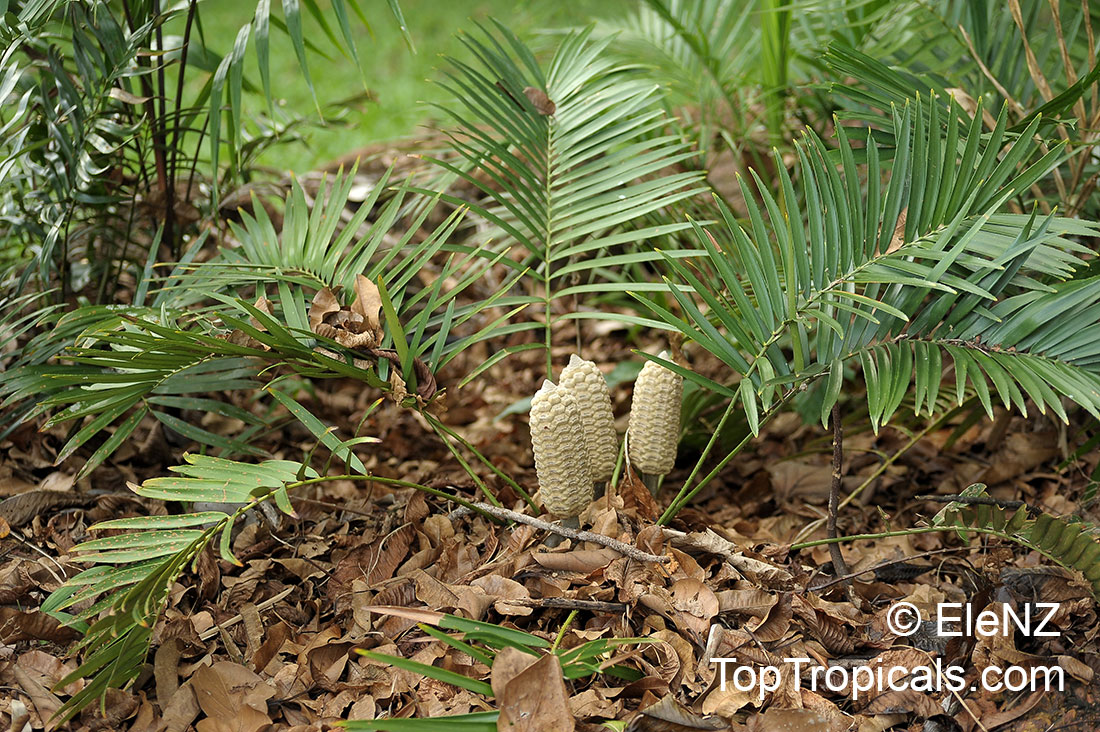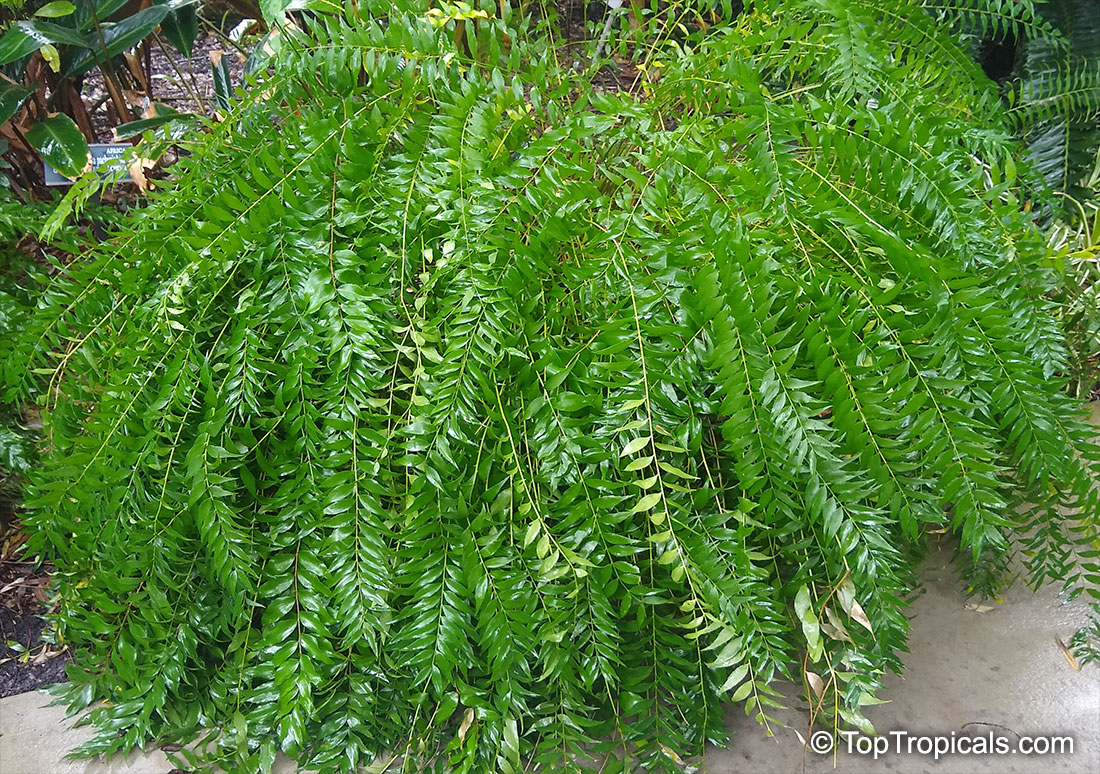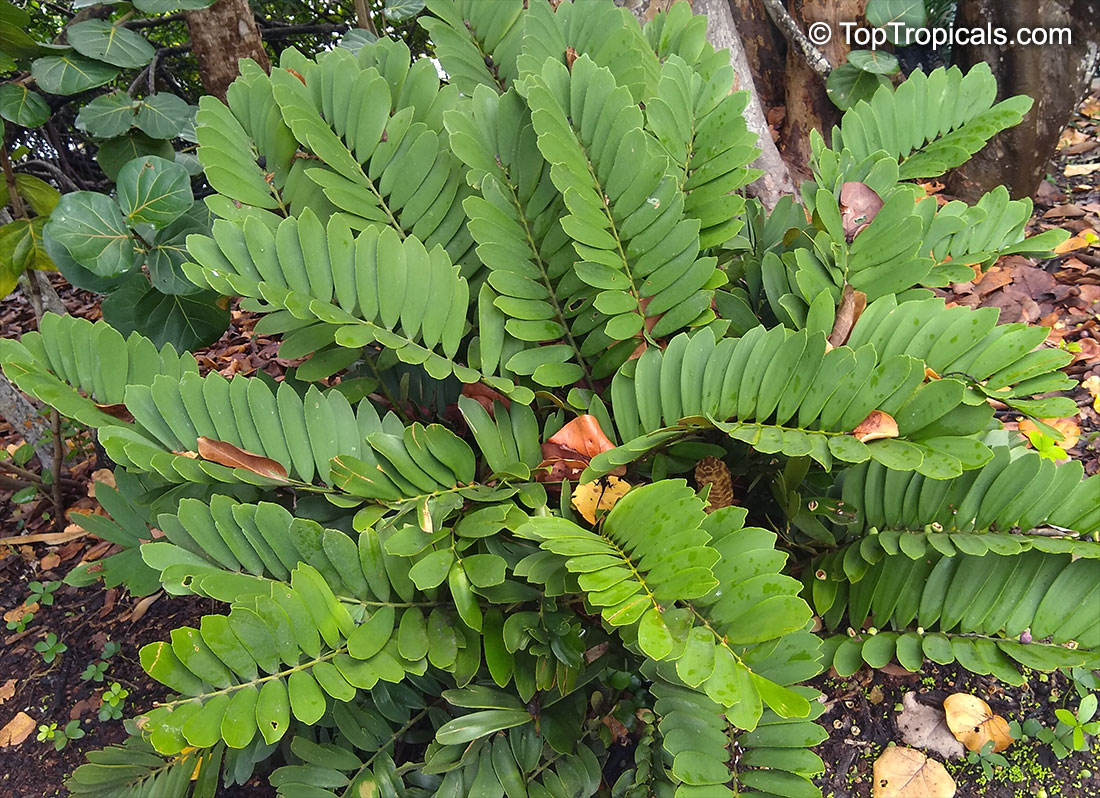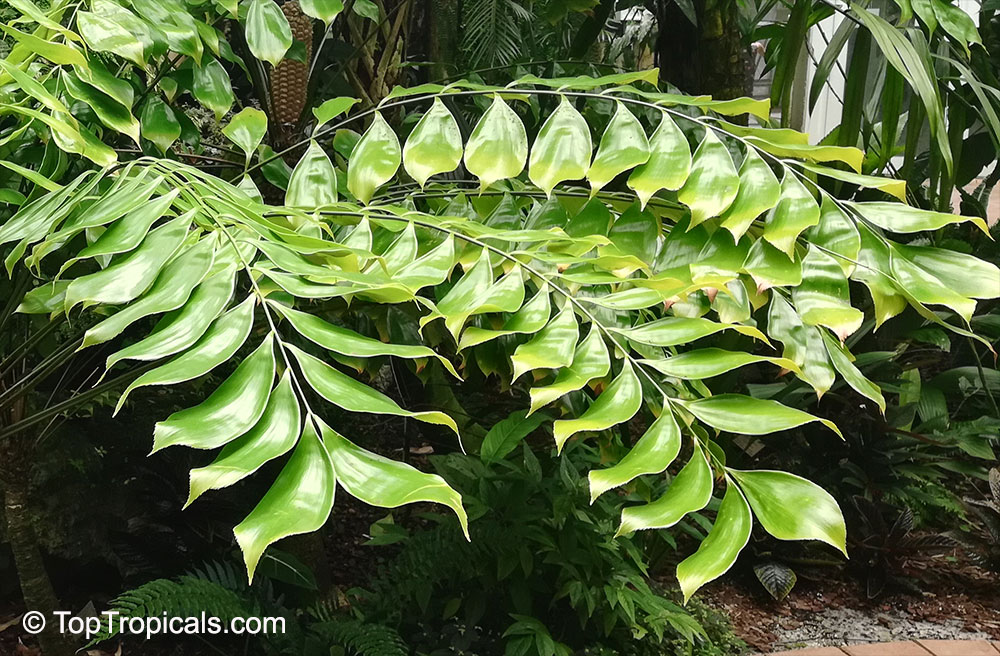Botanical family: Zamiaceae
| Number of plants found: 9 |
Ceratozamia sp.
CeratozamiaFamily: Zamiaceae
Origin: Central America, Mexico





The plants are dioecious, with a globose or cylindrical stem, rarely dichotomously branched, that may be underground or emergent. The leaves are pinnately compound, straight, and spirally arranged. Leaf bases are usually deciduous but sometimes persistent. The petioles and rachis often have spines, though there may be very few to none. Leaflets are simple, entire, and articulate at the base, with parallel side veins and no distinct central vein.
Dioon sp.
Virgin PalmFamily: Zamiaceae
Origin: Mexico







Dioon mejiae is a popular cycad, suited to subtropical and temperate regions. With its ability to adapt to a variety of climates and conditions, it is widely grown and admired in gardens around the world. It is best suited to full sun and well-draining soils, and benefits from regular watering during summer. It also has great tolerance for light to moderate frosts.
Dioon mejiae is known for its small, palm-like shrub form and attractive, ornamental foliage. It has a natural range from Mexico, with its ability to withstand salt spray allowing it to become an ideal choice for coastal gardens in USDA Zones 9-11. For cold regions, it may be grown in a pot, but special care must be taken to ensure it is situated in sandy, well-draining soil, placed in a sheltered location, and watered and fertilized regularly.
When planting Solanum torvum, it is recommended to incorporate compost or other organic material into the soil. To ensure optimal growth, its roots must be kept moist but not overly wet, and its fronds should be pruned regularly to shape and encourage healthy new growth, as well as to remove any dead or damaged parts of the plant. With its abundance of rich colors and sweet aromas, this species is a beautiful sight to behold and can bring a magical effect to any garden with proper care.
Encephalartos ferox
Tongaland CycadFamily: Zamiaceae
Origin: South Africa







Encephalartos ferox is a small shrub that originates from South Africa. It typically grows to a height of between 2-5 ft and is well known for its attractive dark green foliage. But that's not all - it also has spectacular orange-red to scarlet cones, adding an extra dramatic element.
This plant prefers full sun and regular water. It is able to tolerate moderate water, but should not be exposed to waterlogged soils. Be aware when handling this plant - it can be quite thorny or spiny and should be handled with care.
In terms of cold hardiness, the mature plants can tolerate temperatures of at least 30 degrees Fahrenheit during short periods. It is suitable to be grown in USDA zones 8-11. If you are looking to grow this plant in a pot in cold regions, you will need a large container to provide protection against the cold weather and to ensure that soils do not get waterlogged. For protection against frost, cover the container with a thick blanket. Avoid over-watering the plants as this can cause root rot, and ensure to water it moderately and deeply. Pruning may be necessary to contain its size and shape, as needed.
Encephalartos horridus
Eastern Cape Blue CycadFamily: Zamiaceae
Origin: South Africa






This is a very hardy, adaptable, relatively slow-growing cycad and suited to temperate and subtropical regions. This is one of the famous "blue" Encephalartos.
Lepidozamia peroffskyana
Pineapple ZamiaFamily: Zamiaceae
Origin: Australia







Pineapple Zamia is a large and fast growing shrub (up to 5-10 ft tall) and in time may form a small tree (10-20 ft).
A native to Australia, Lepidozamia peroffskyana (Pineapple Zamia) is a large and fast growing shrub or small tree that carries cones that are among the largest of all cycad cones. Its long, dark green fronds usually reach around 10-20 ft in height and have a palm-like structure.
Pineapple Zamia is a hardy shrub and prefers well-drained soil but does not like to become too dry. It does best in a semi-shaded area and needs regular watering, especially during summer when it is active and growing. When planting in the ground, use moderate water throughout the year.
Those growing Pineapple Zamia in cold climates like USDA Zone 9-11 can try growing it in a large pot that can be easily shifted indoors for the winter season. Make sure the pot holds enough volume for the root system and has good drainage, as too much water could damage the roots of the plant. Throughout the winter season, use only enough water to keep the soil barely moist.
When caring for a Pineapple Zamia, keep in mind that it is very vulnerable to over-watering and should not be overwatered. As it is not tolerant of high salts, keep the soil around the plant free of fertilizers and salts. It is also sensitive to drastic temperature changes and cares should be taken while shifting the plant indoors or outdoors. Finally, use plenty of organic mulch to maintain the moisture in the soil, as it will help to avoid drought and nutrify the soil.
Zamia furfuracea
Cycad, Cardboard PalmFamily: Zamiaceae
Origin: Southeastern Veracruz, Mexico
USDA Zone: 9-11?








This is a "living fossil" plant, surviving on earth since the time of the dinosaurs. Cardboard Palm belongs to the Cycad family (cycad is greek for "palm" which many cycads resemble). Other cycads include Coontie Palm and Sago Palm (neither of these are really palms!) Cardboard Palm has 3 to 4 foot leaves that emerge from a central point forming a rosette. When grown in bright sunlight the rosette becomes a 3 foot high clump of tightly overlapping leaves that will slowly grow to 6 feet in diameter. The thick leathery leaves are pinnate and have 5 inch long by 1 inch wide oval leaflets. They are slightly fuzzy and feel a little like cardboard when rubbed (hence the name Cardboard Palm!) The foliage emerges from a thick fleshy trunk that serves as a water reservoir in times of drought. Male and female reproductive structures (cones) form on separate plants. Even very young plants produce these interestingly shaped cones. When ripe, the female cone breaks to reveal an array of tightly packed, bright red 1 inch seeds. Location Cardboard Palm is native to the warm sandy coastal plains of Mexico and is a common landscape item in tropical and sub-tropical areas all over the world. It is also a popular and easy to grow houseplant. Plant in neutral, well-drained sandy soil. Mulch with organic materials (bark or leaf mold). Sustains leaf damage at 28 degrees F. Cardboard palm makes a great accent or specimen plant. Use near the patio, in mixed foundation plantings or in perennial beds. This cycad is salt resistant and can be used in beachside plantings. Also makes a great container plant for the patio or deck. It is a great houseplant tough enough to survive occasional neglect and harsh indoor environments. Large outdoor clumps are striking as the light olive green new growth emerges to hover above a base of darker mature leaves. Specimens can be grown indoors in shallow containers. Used this way, the partially exposed tuberous stem and the airy crown of leaves create a striking bonsai specimen. With it beautiful shape, exotic looking cones and instinct for survival, Cardboard Palm is one of the favorite indoor plants.
Zamia integrifolia, Zamia floridana
Coontie, Coontie Palm, KoontiFamily: Zamiaceae
Origin: South of the USA, western Cuba, Puerto Rico, and the Cayman Islands
USDA Zone: 7-10?










Zamia integrifolia, commonly known as Coontie or Koonti, is a small, woody cycad native to the southeastern United States, the Bahamas, and the Caribbean. It is also found in Grand Cayman and the Dominican Republic, but it is believed to be extinct in Puerto Rico. This plant is prized for its medicinal properties and is used to treat digestive and urinary tract disorders, as well as to promote wound healing. It is also popular as an ornamental groundcover due to its low-growing habit and ability to thrive in a variety of soils, including seaside and salt-tolerant areas. In cold regions, Zamia integrifolia can be grown in pots and brought indoors when temperatures drop. It requires full sun or semi-shade and moderate watering.
Zamia integrifolia is found in a variety of habitats with well-drained sands or sandy loam soils and prefers filtered sunlight or partial shade. It is a hardy plant that is easily grown in sub-tropical and warm temperate areas. However, it is becoming increasingly uncommon due to intensive land use. This plant is poisonous and produces a toxin that affects the gastrointestinal tract and nervous system. The toxin can be removed by careful leaching, and the roots and half-buried stems were traditionally used by Native American people for their sago-like starch. The root is typically prepared for food by grinding it using a wooden mortar and pestle, and the resulting flour is used in various dishes.
Plant care: Plant in a location that receives full sun or semi-shade and has well-drained sandy soil. Water moderately, making sure not to overwater. In cold regions, the plant can be grown in pots and brought indoors when temperatures drop. Protect the plant from strong winds, as they can damage the leaves. If necessary, prune damaged or diseased leaves to maintain a healthy appearance.
Because Zamia integrifolia is poisonous, take care when handling the plant and keep it out of reach of children and pets.
Use link to repeat this search:
https://toptropicals.com/cgi-bin/garden_catalog/cat.cgi?search_op=and&keyword_op=and&language=e&family=Zamiaceae &number=10
&no_change_lang=1&user=tt&sale=1&first=0
